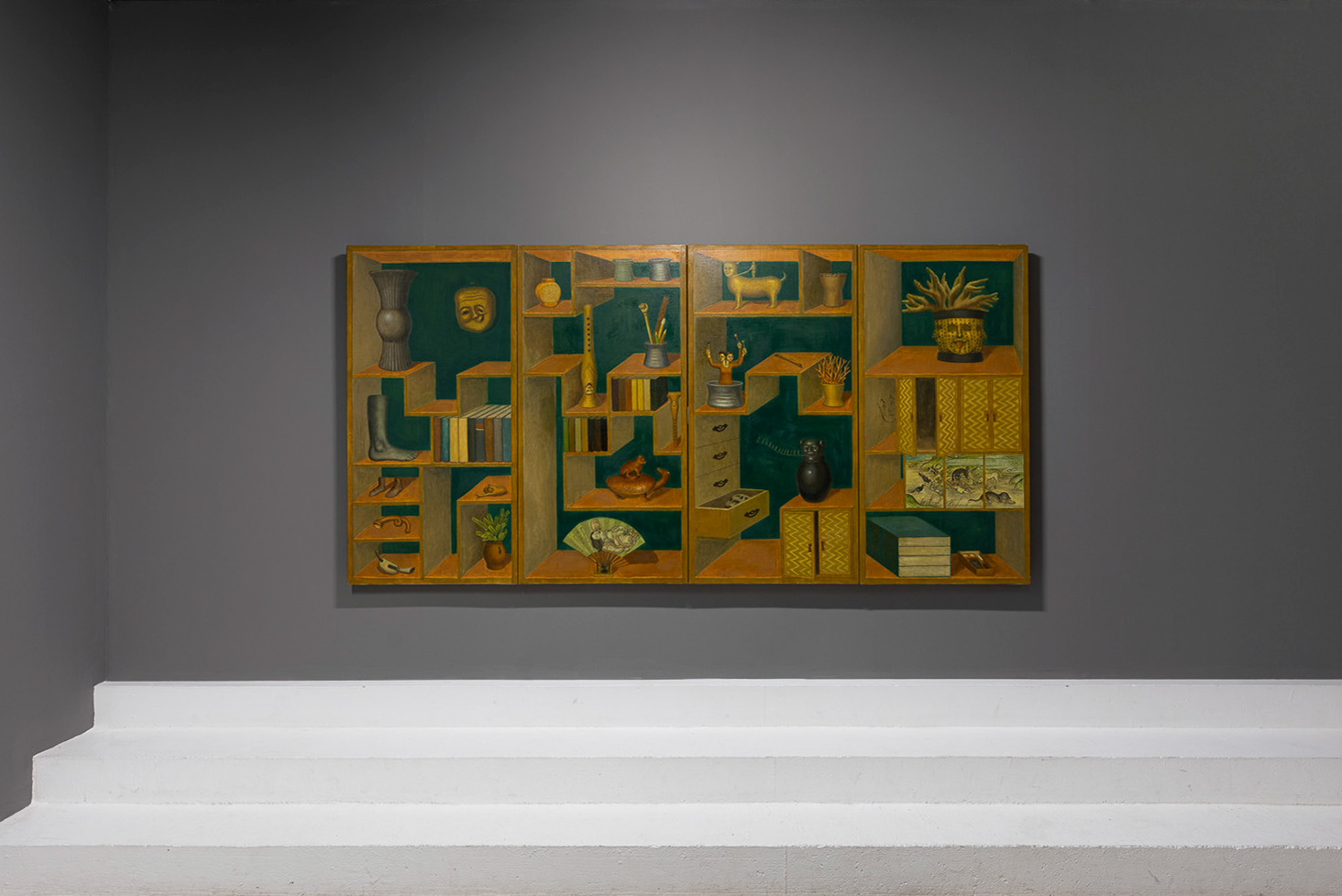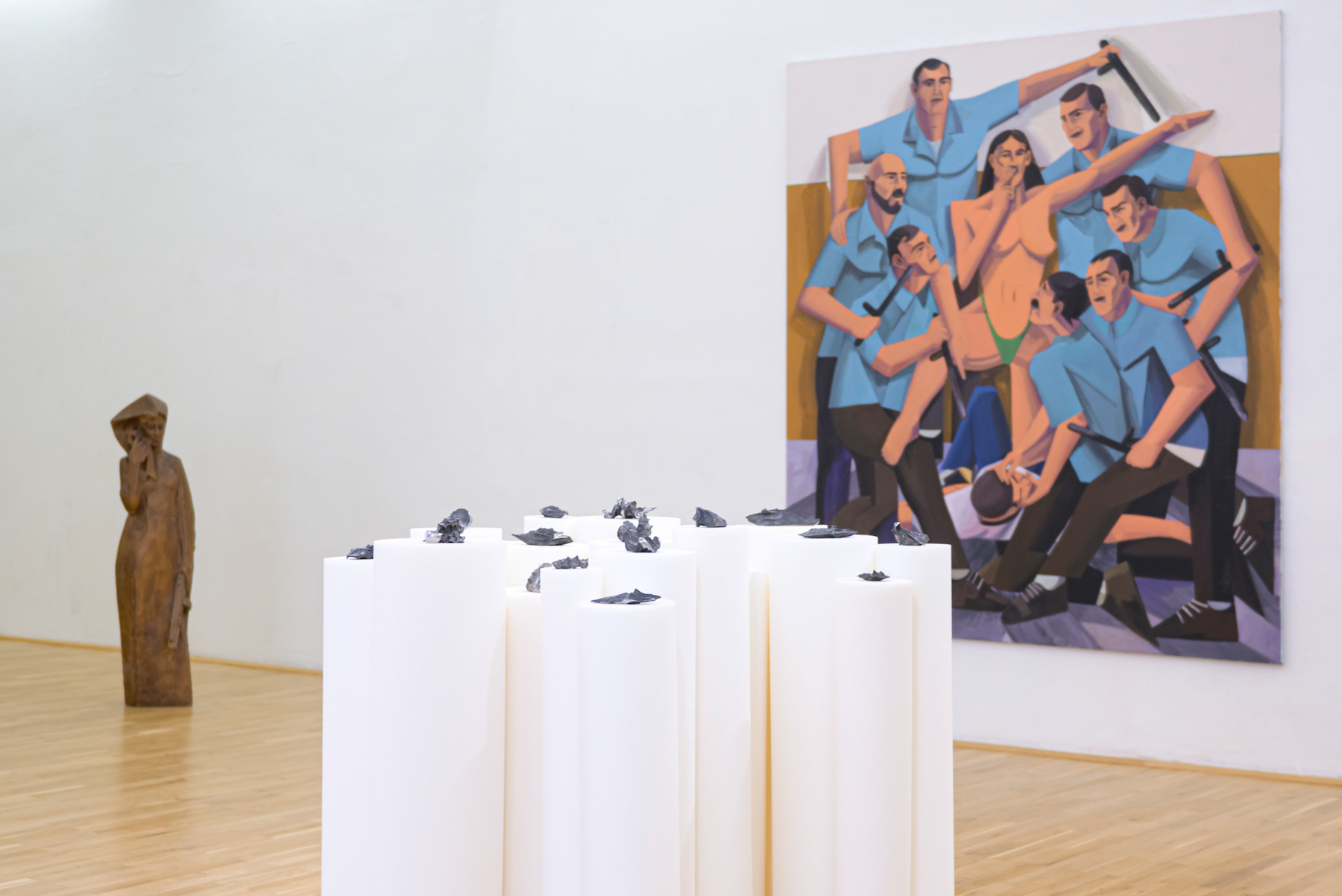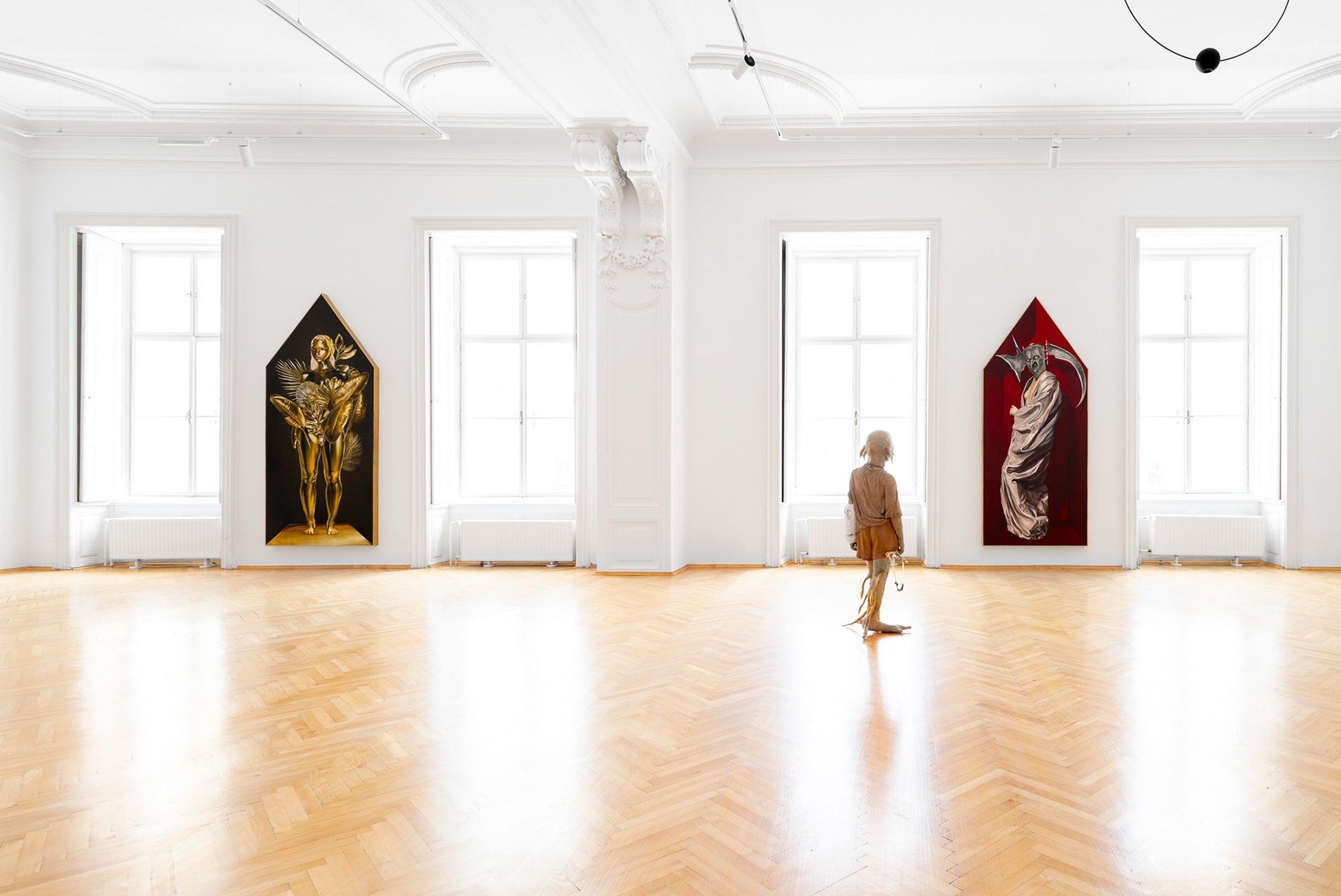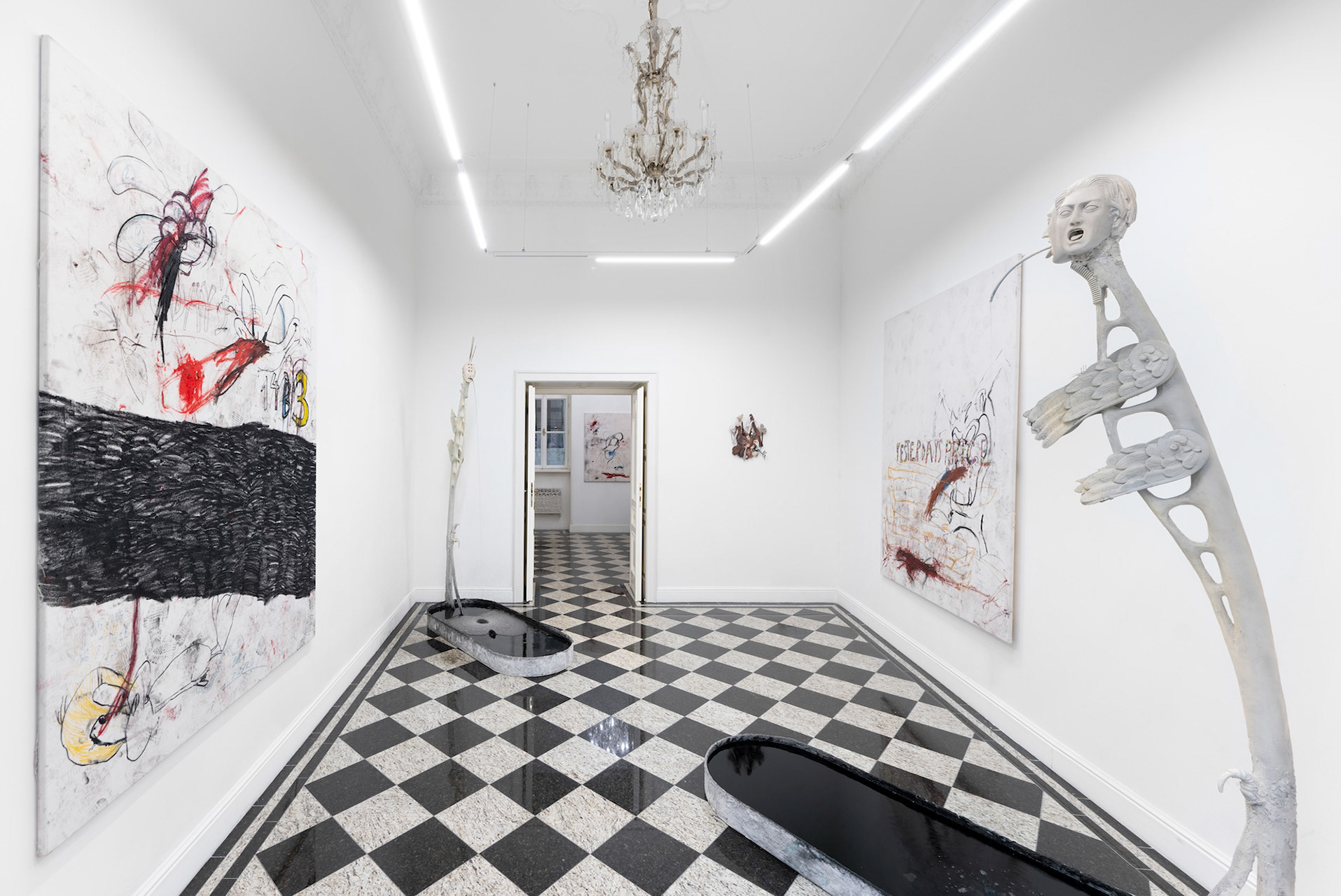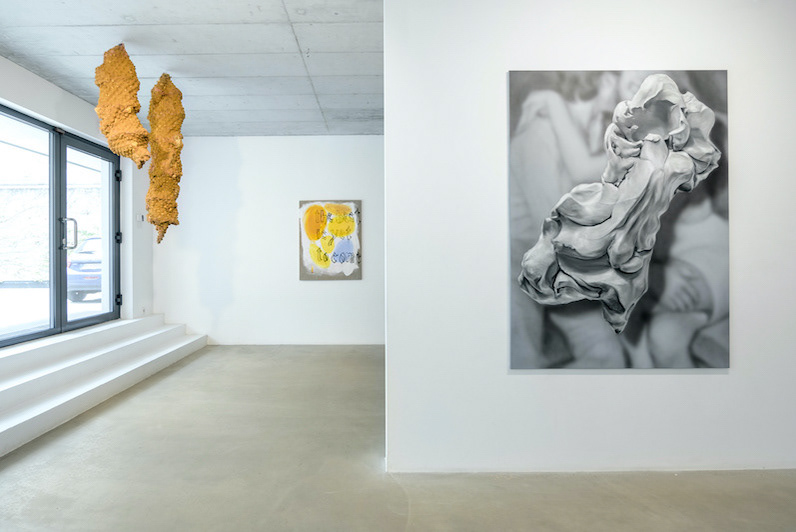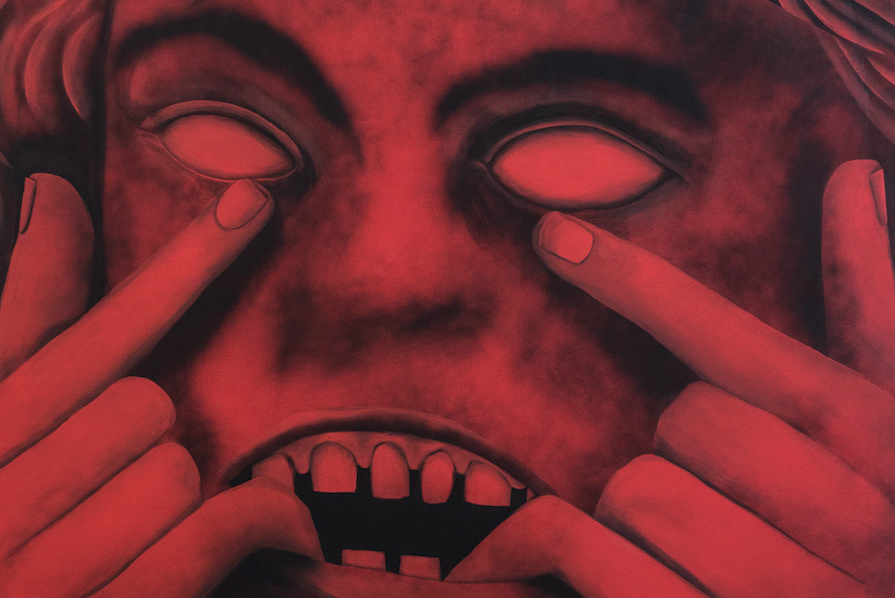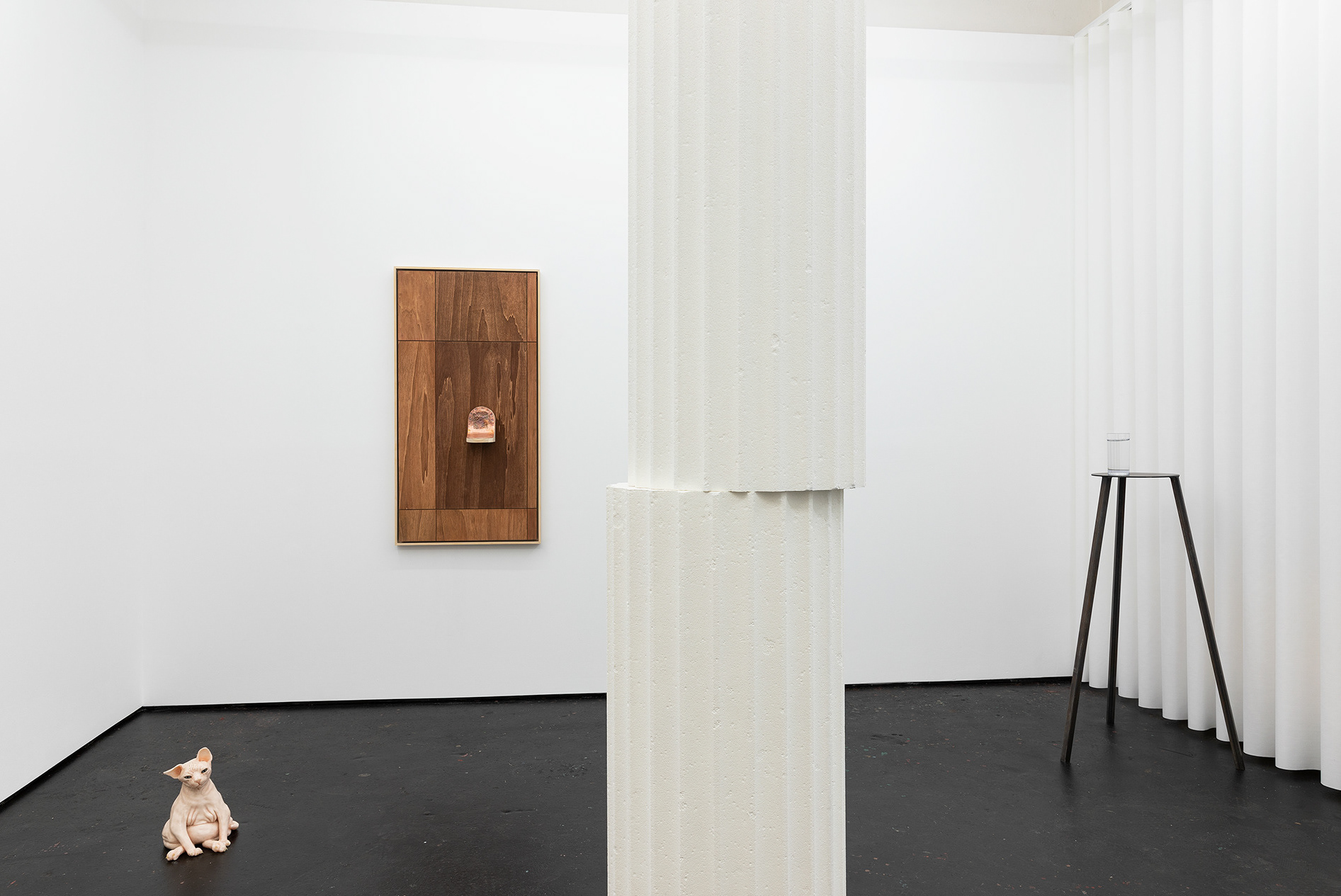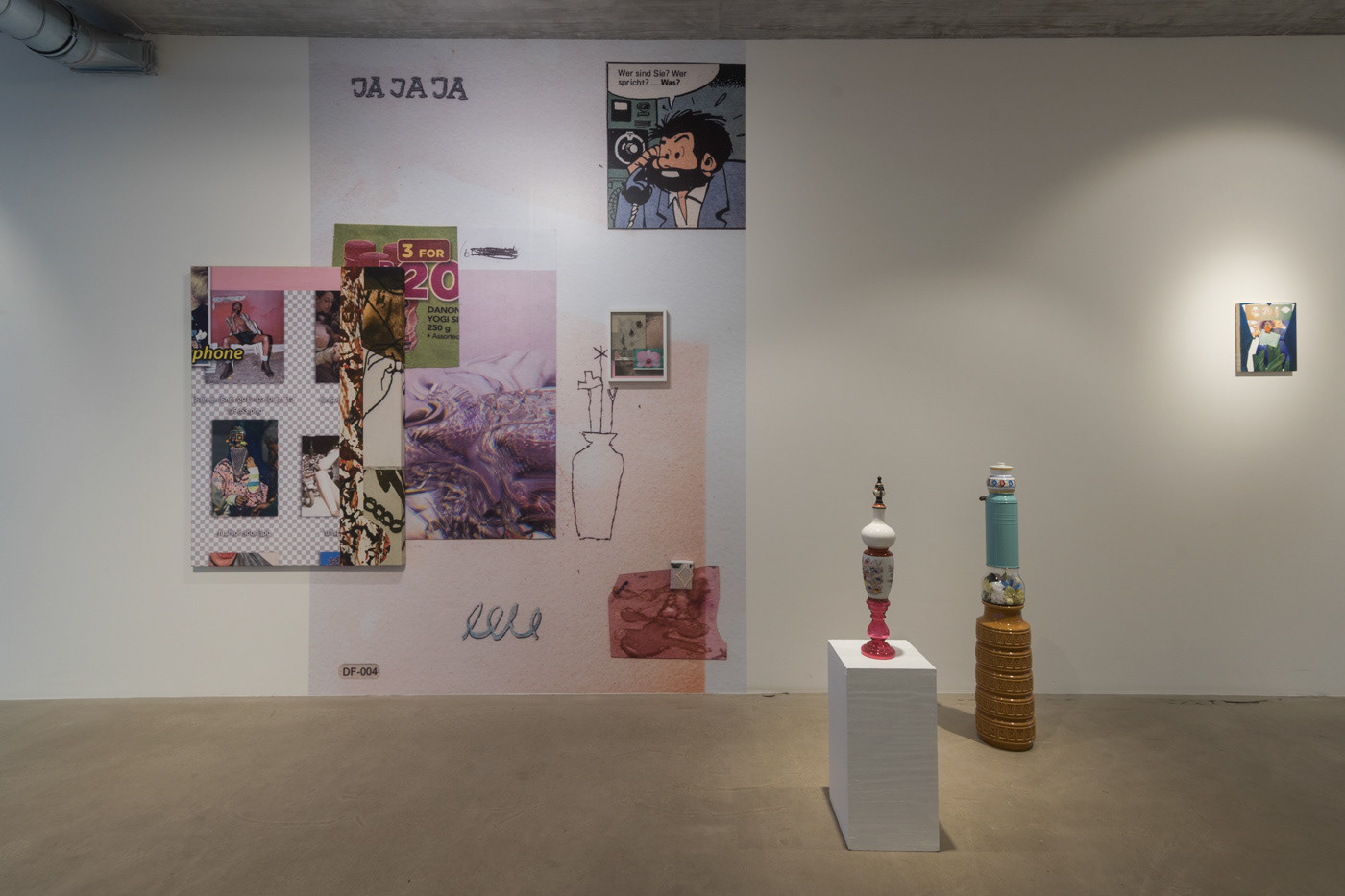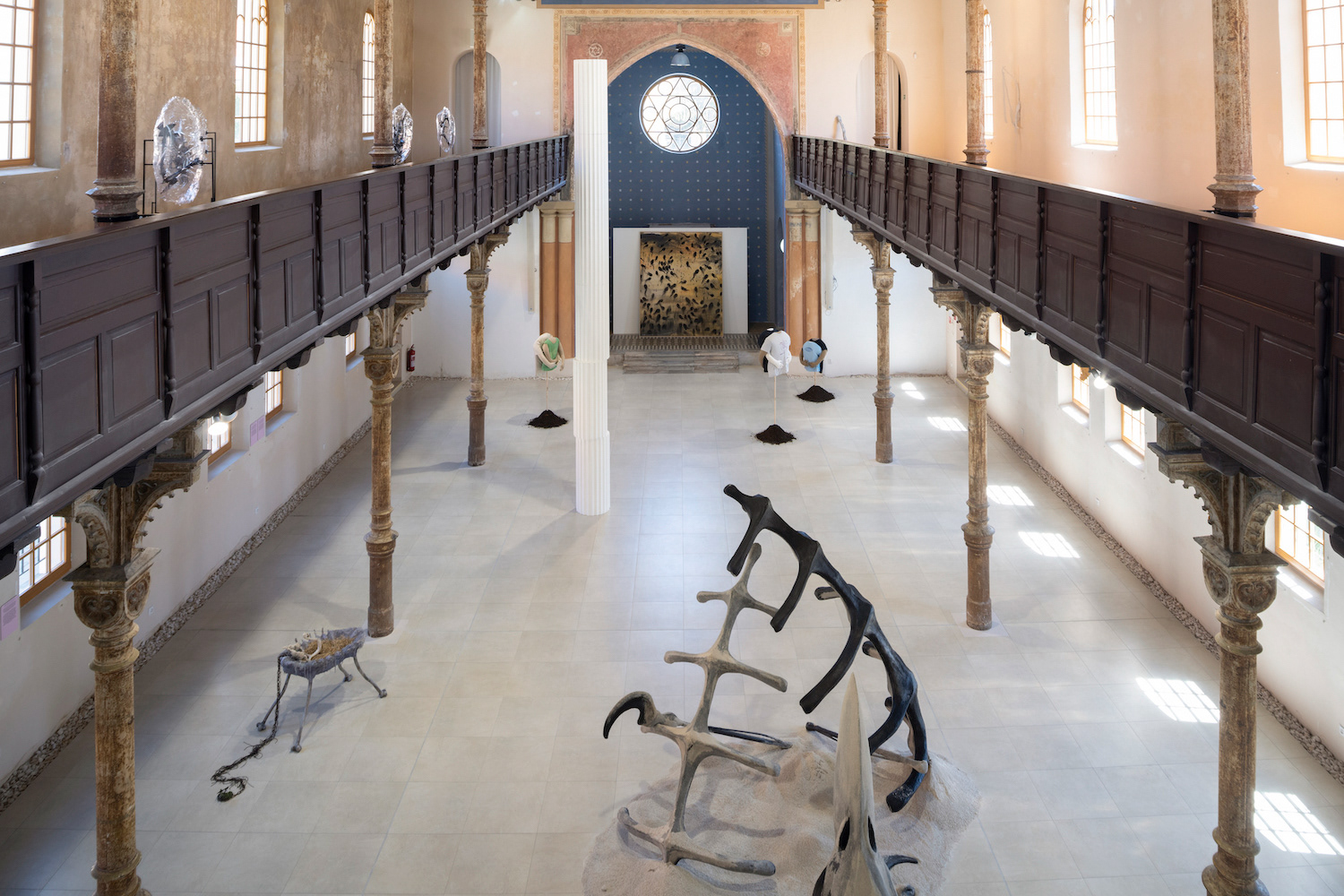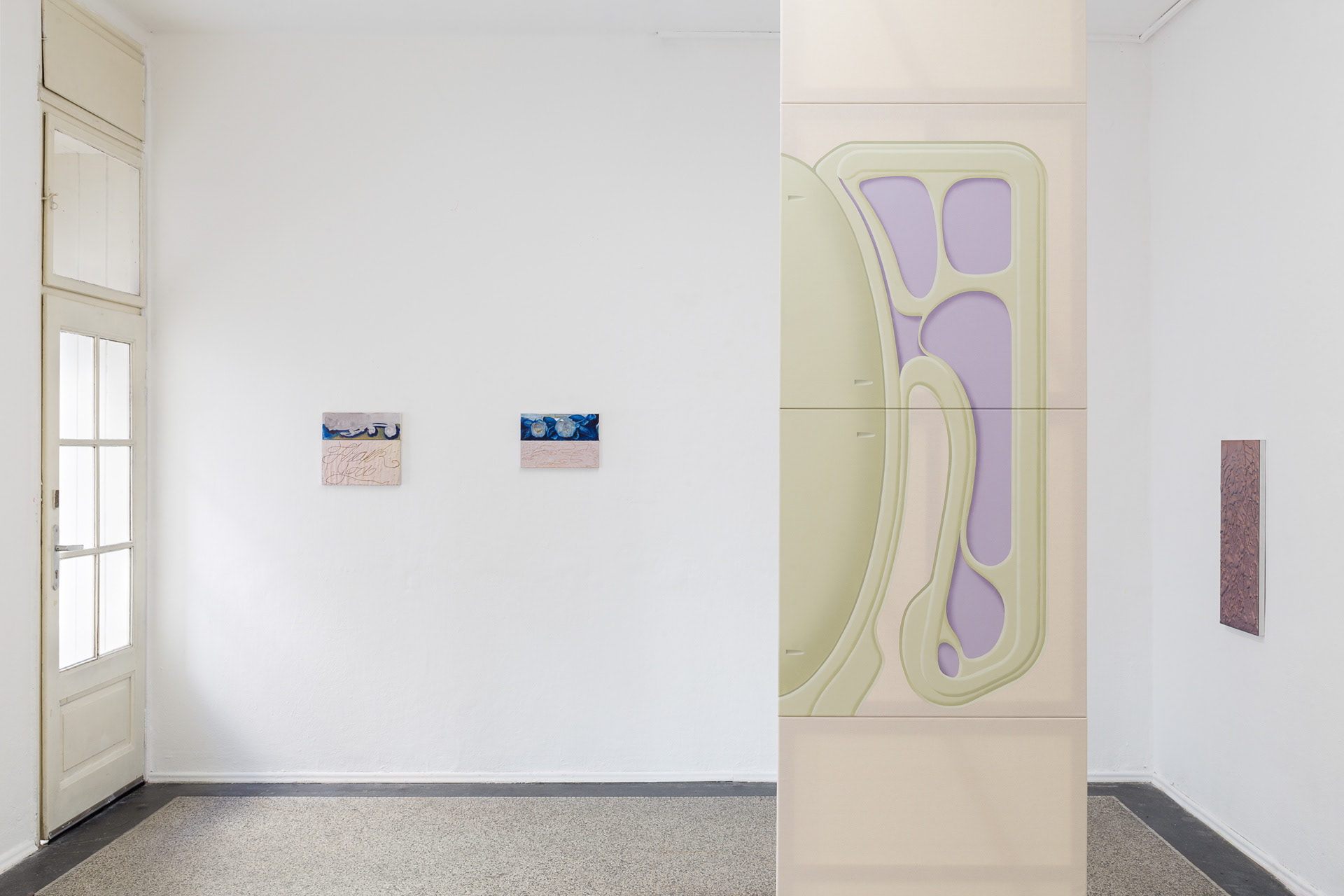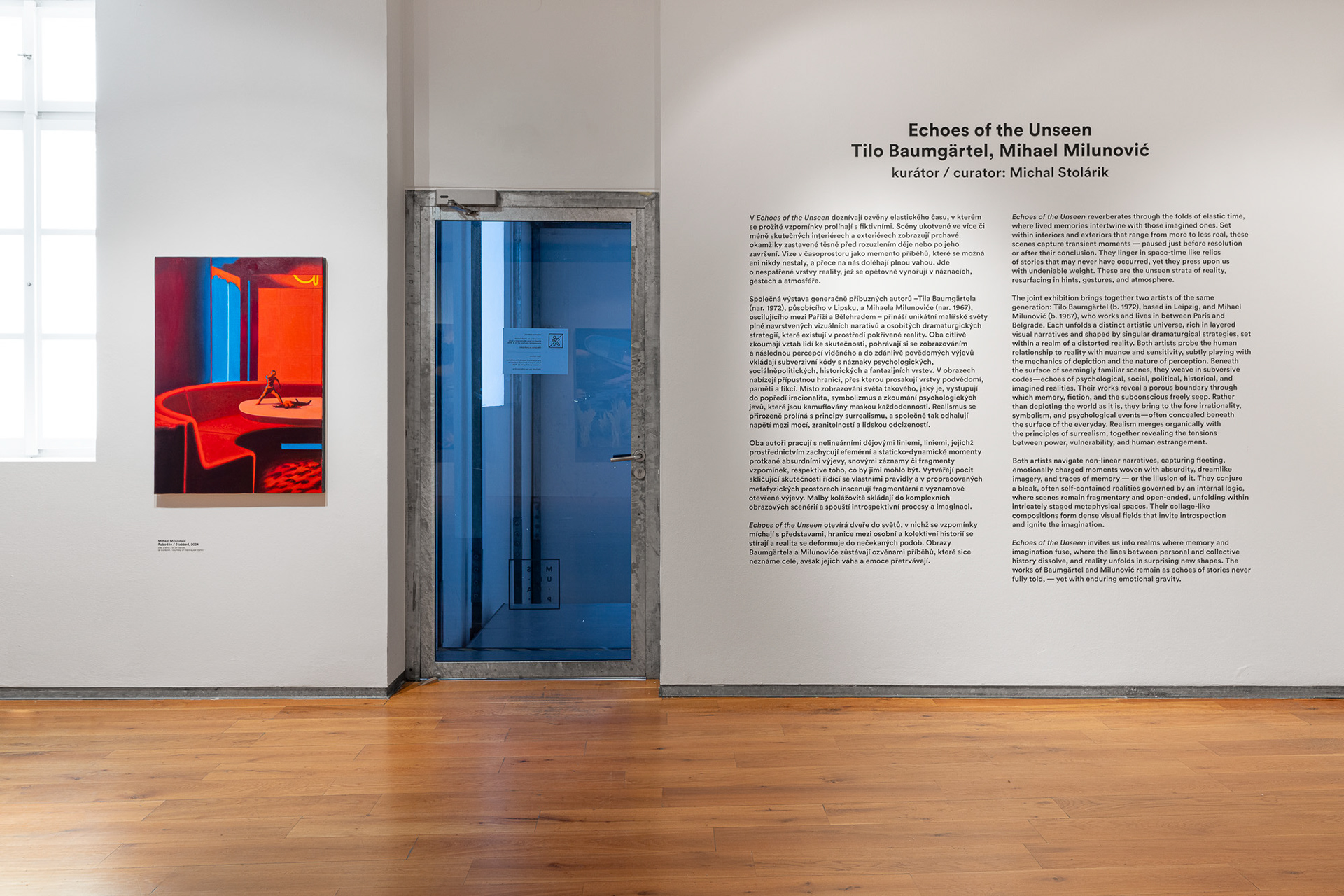
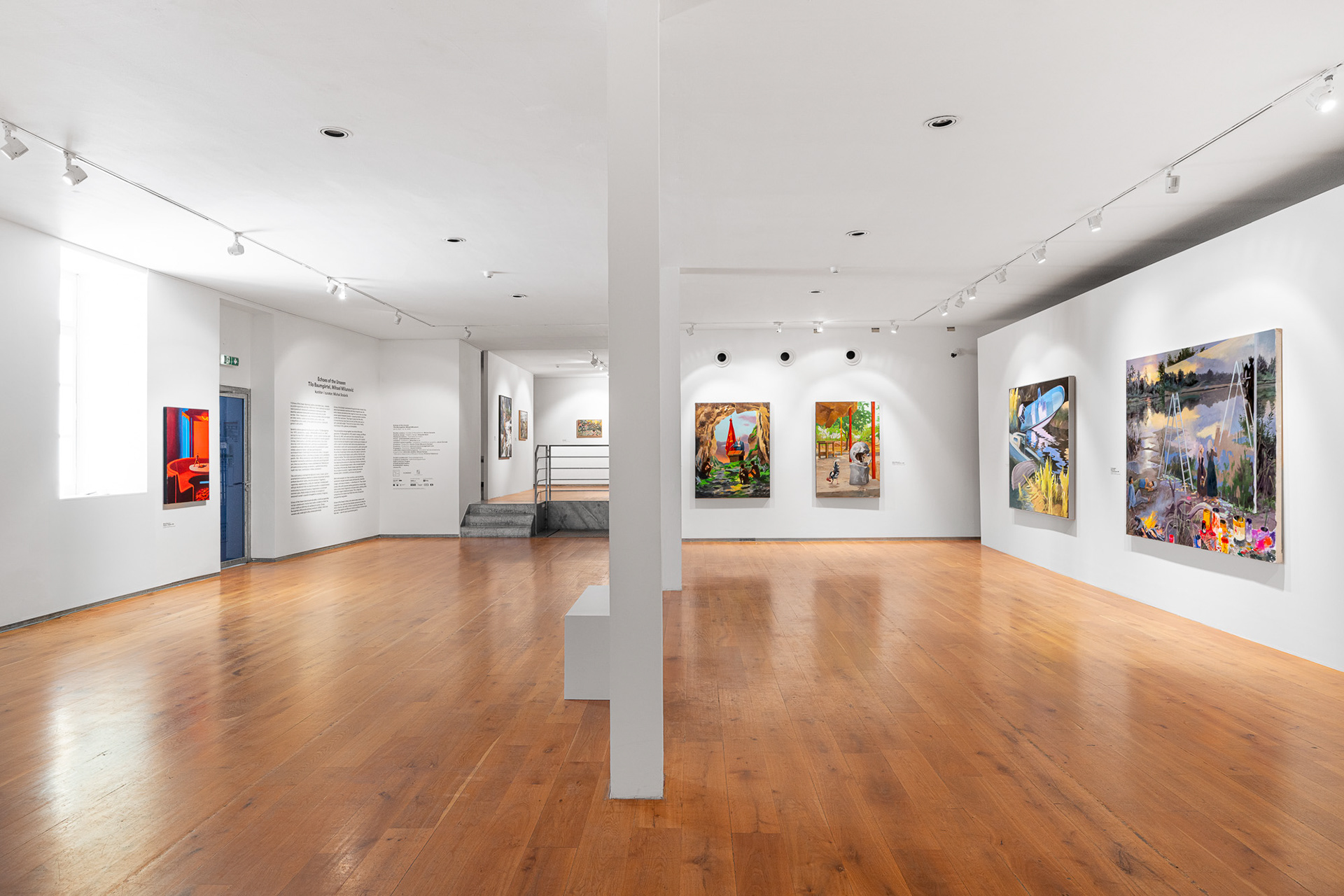
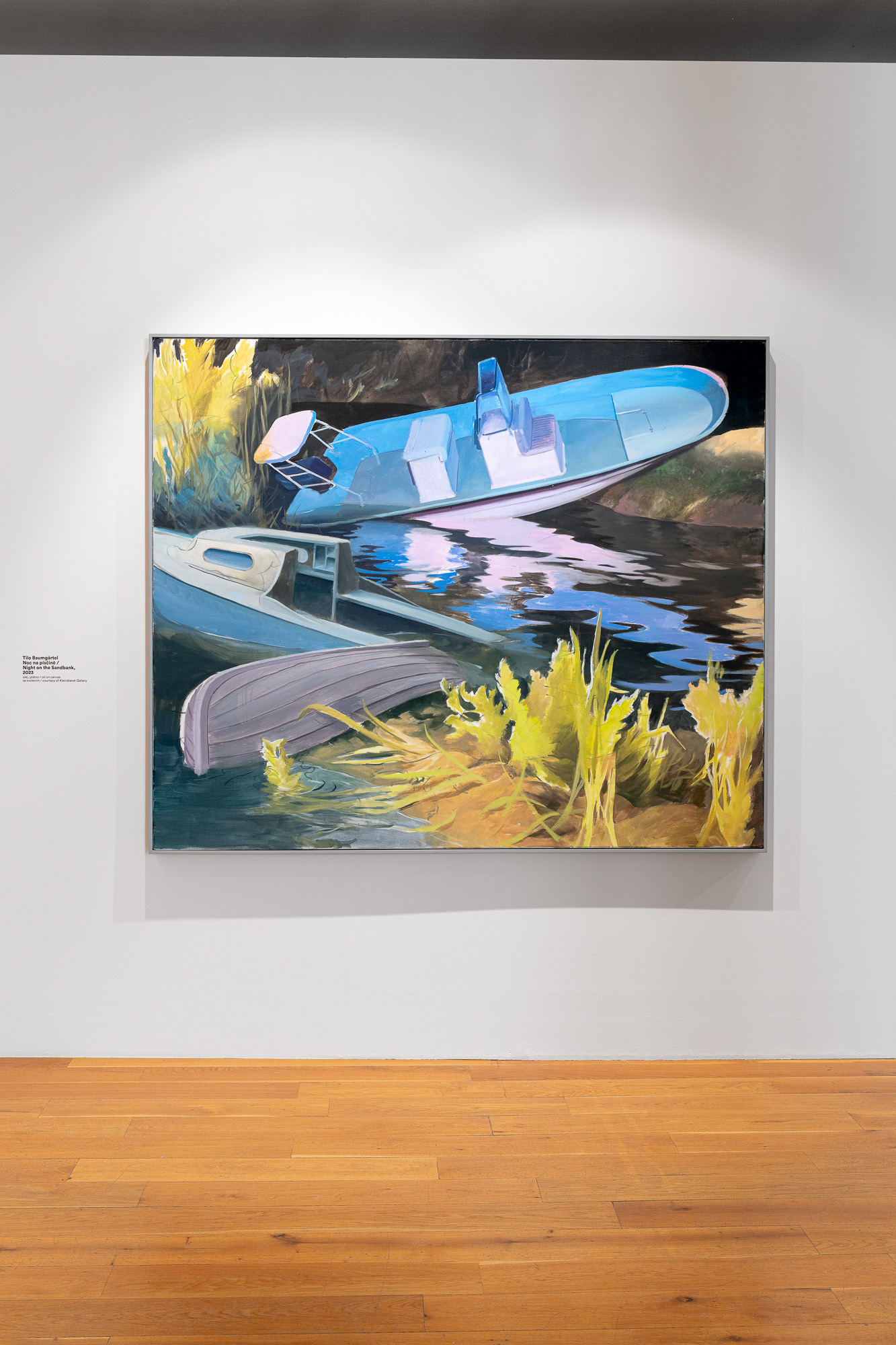
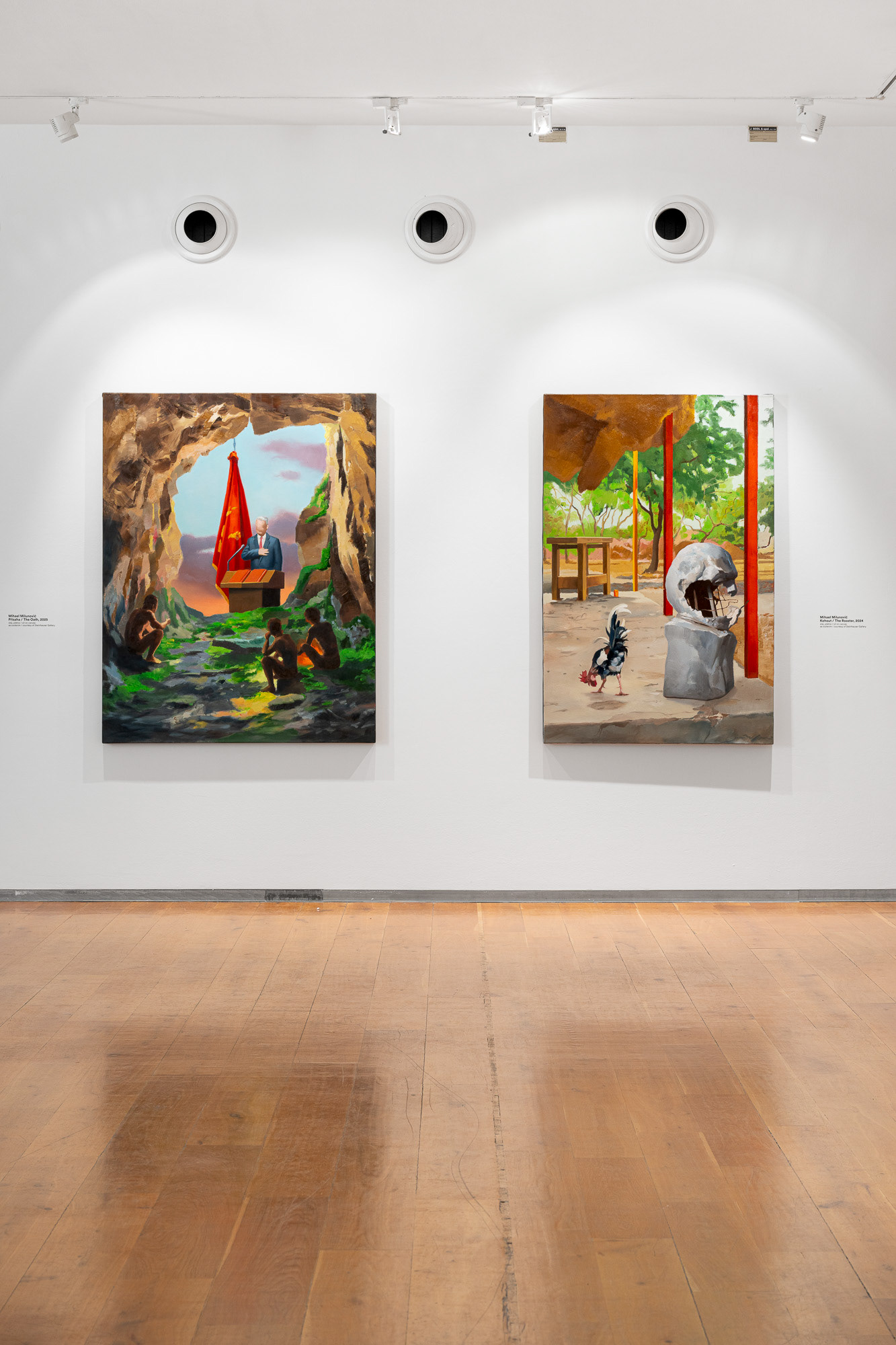
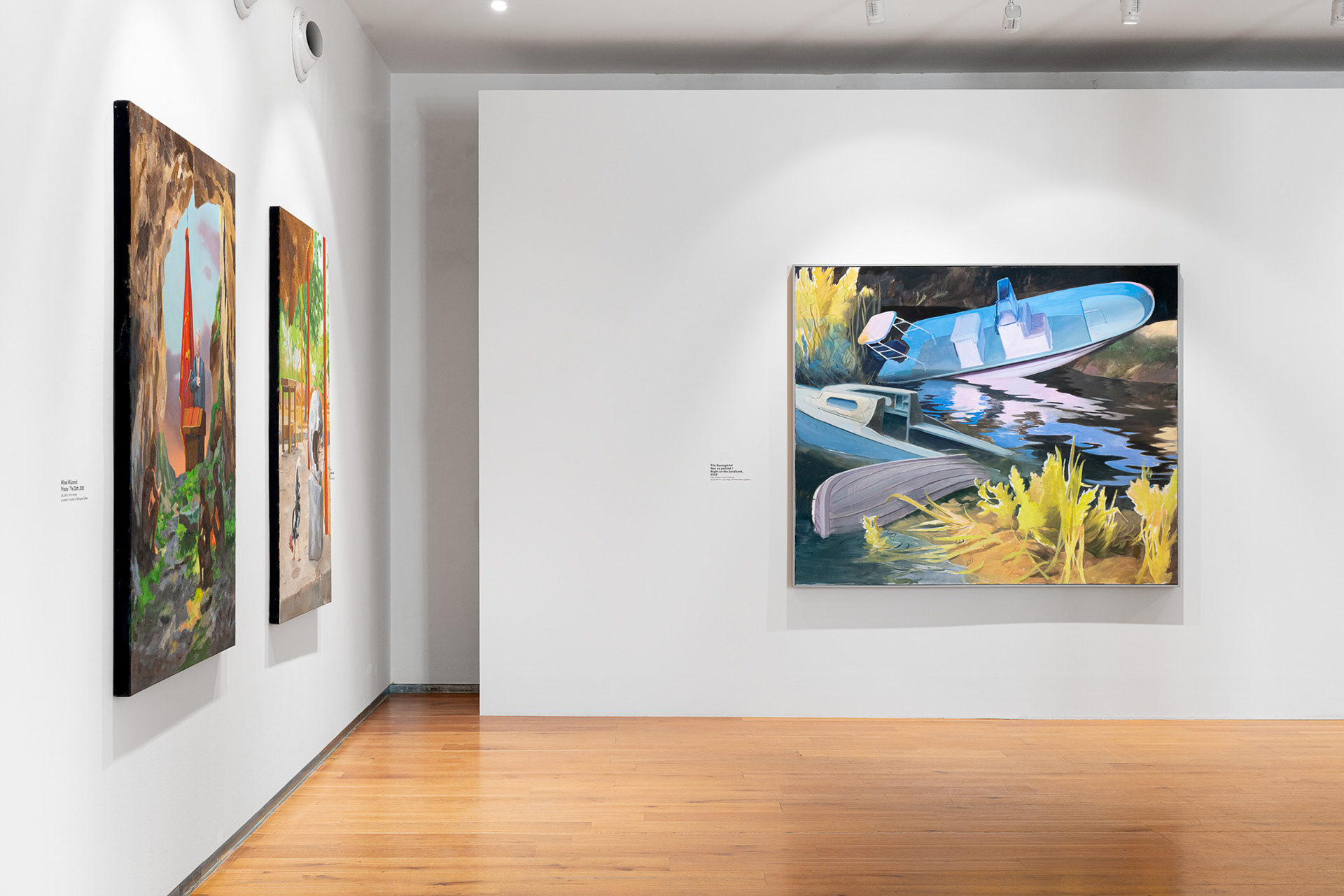
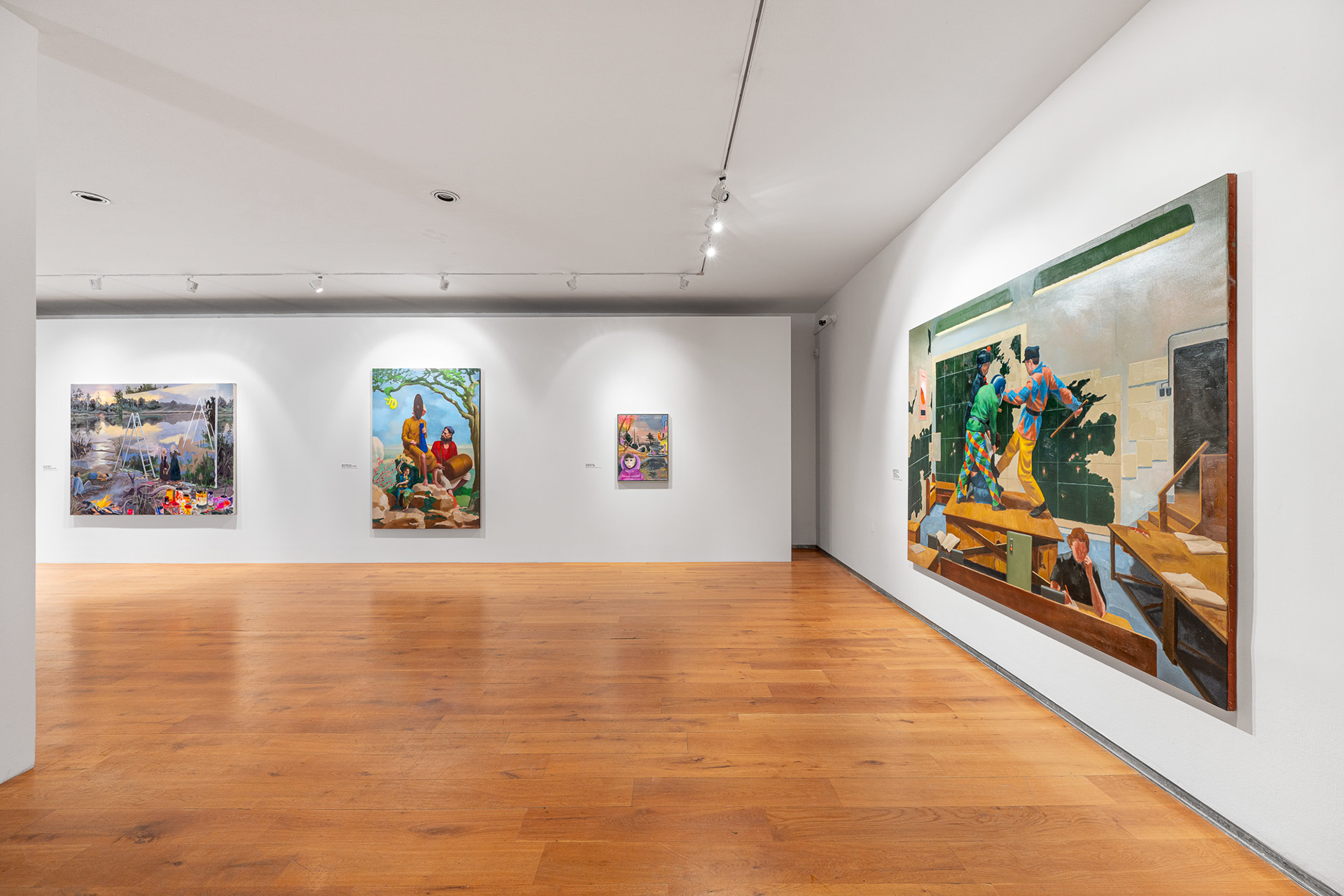
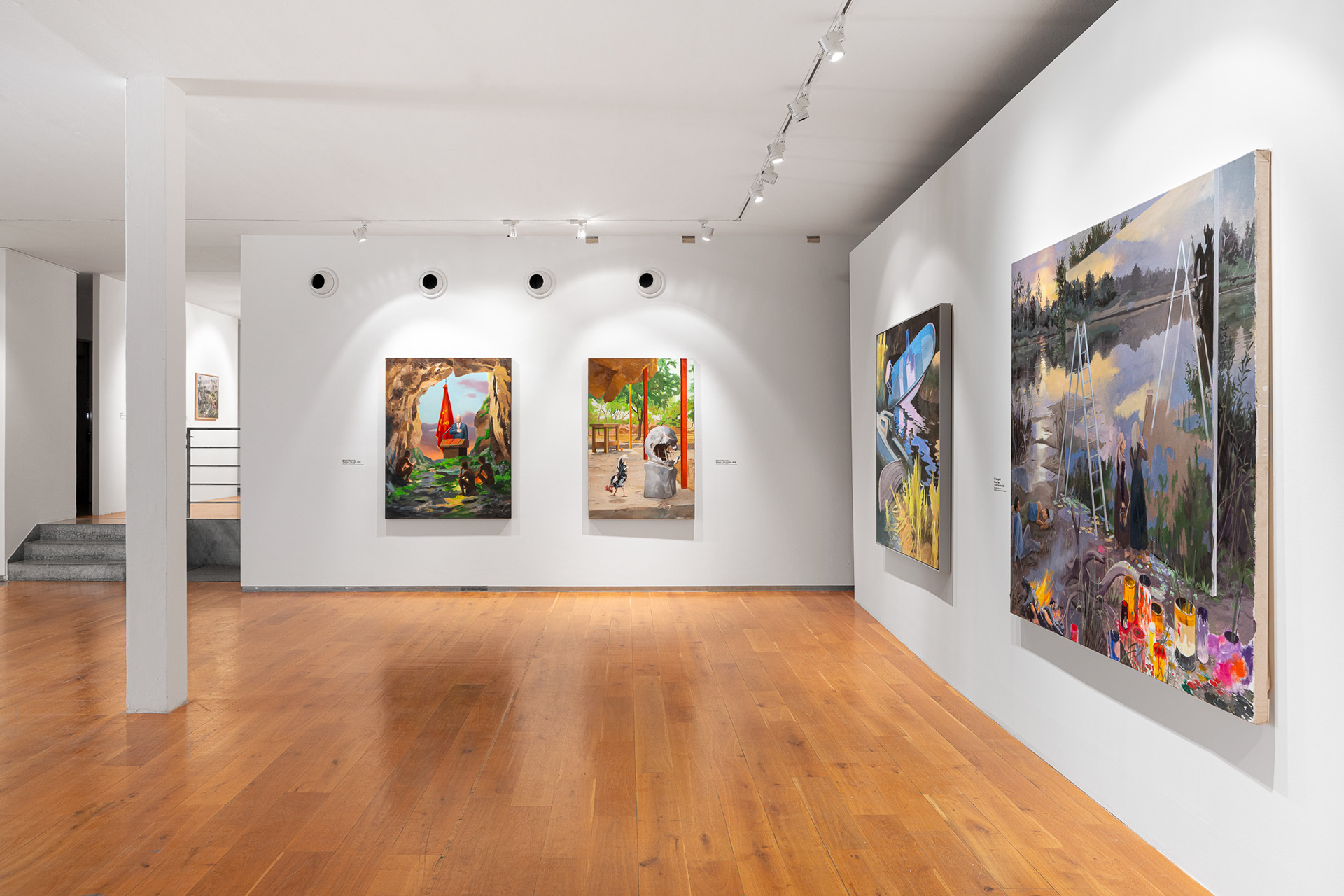
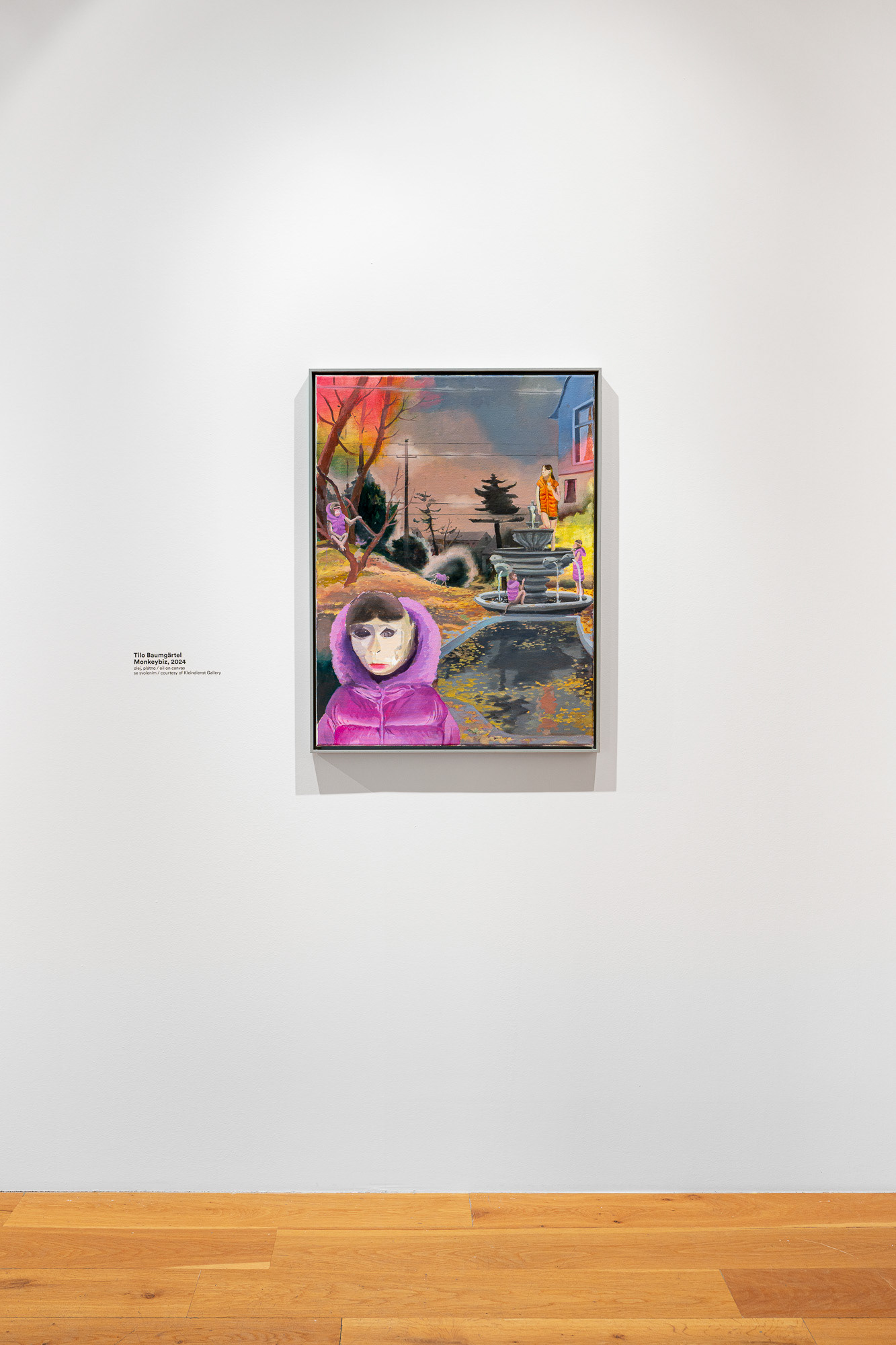
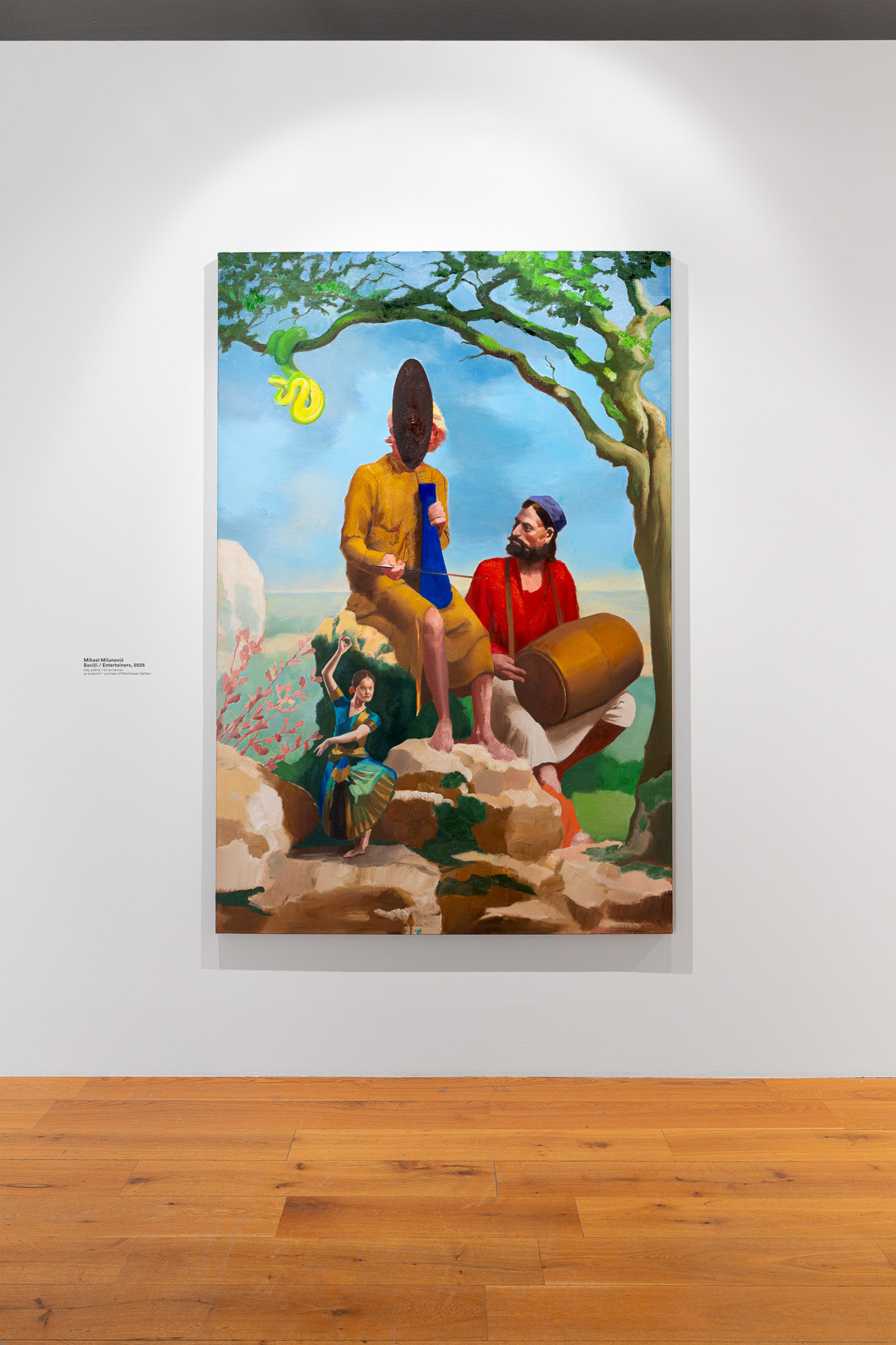
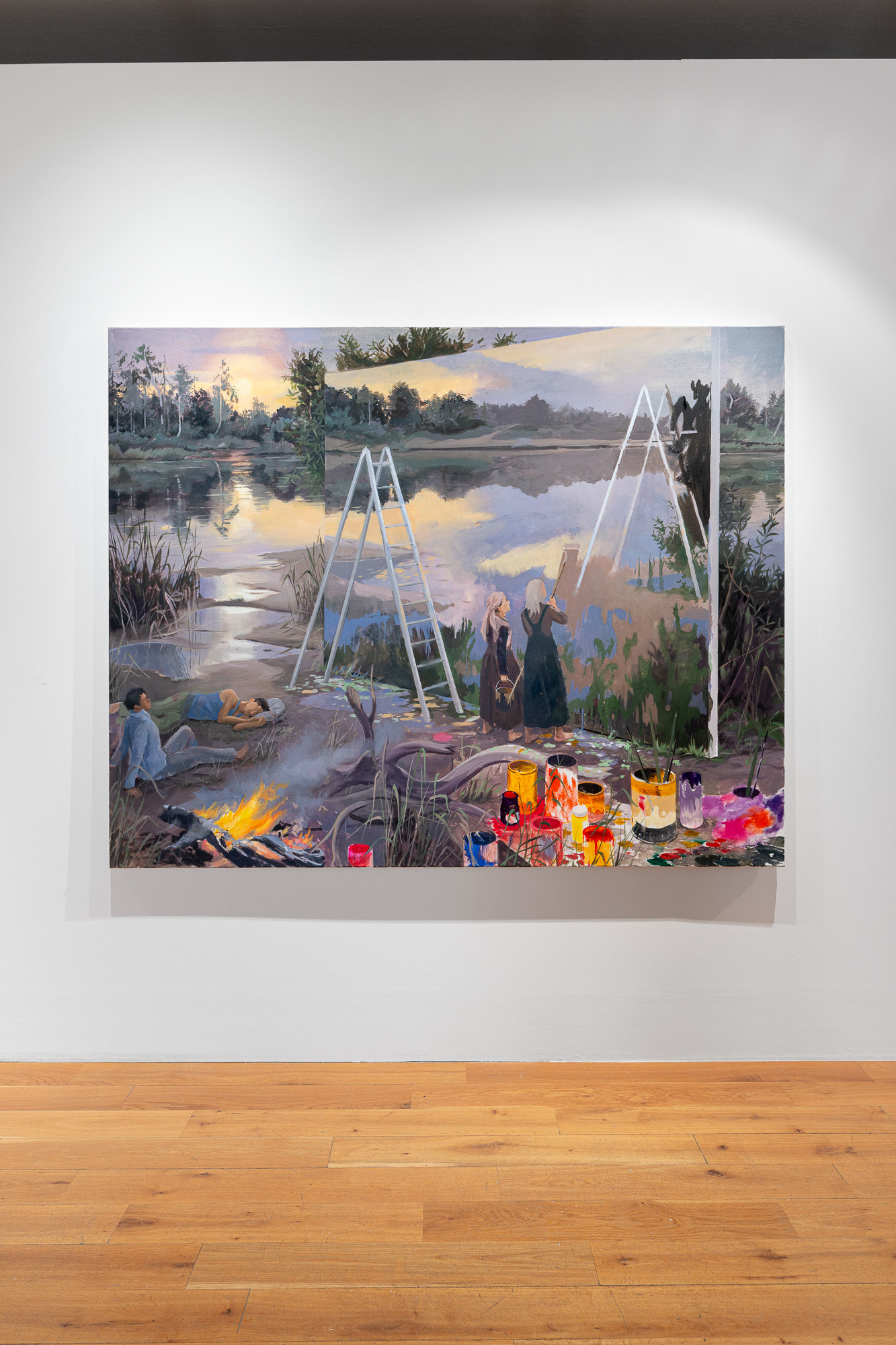
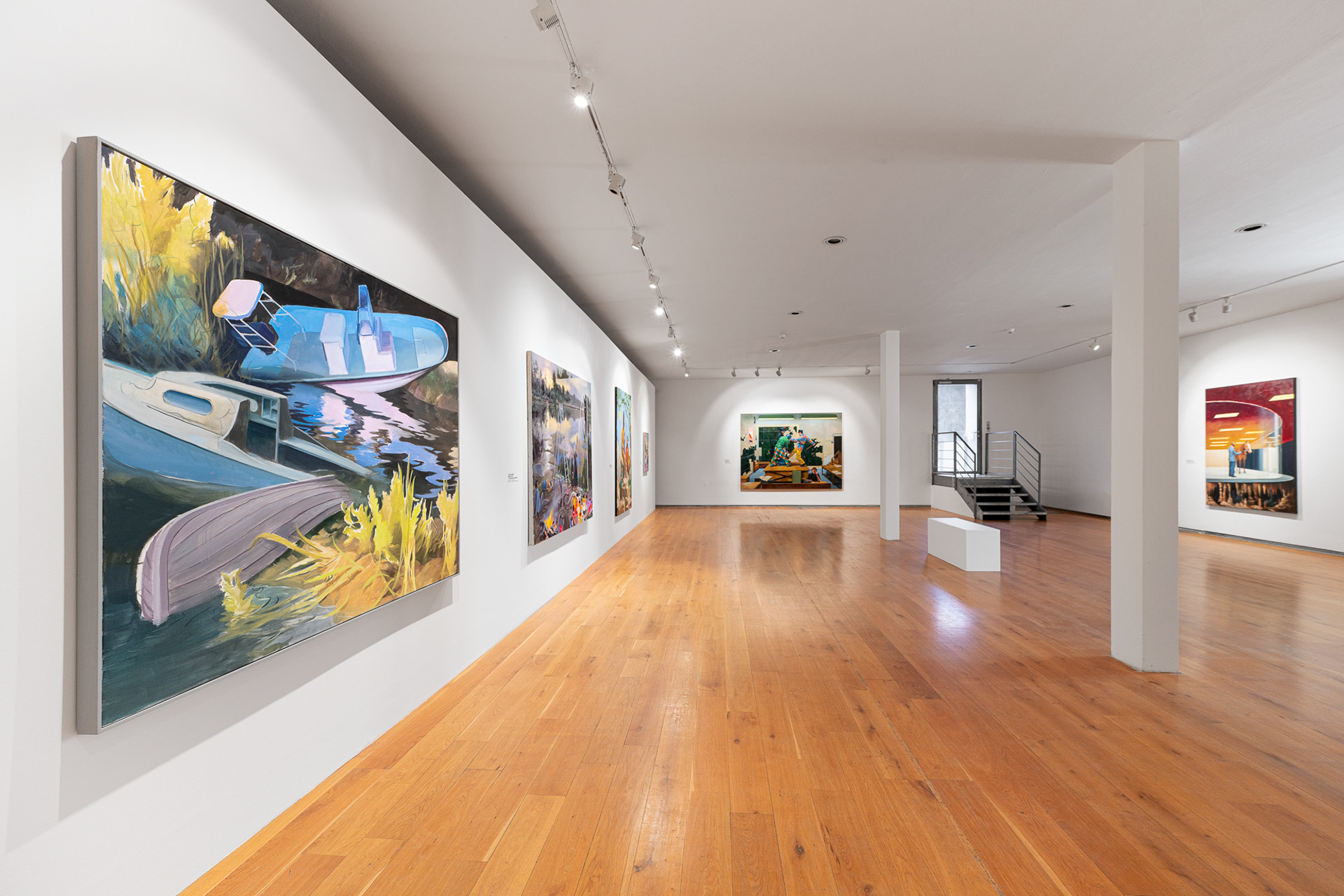
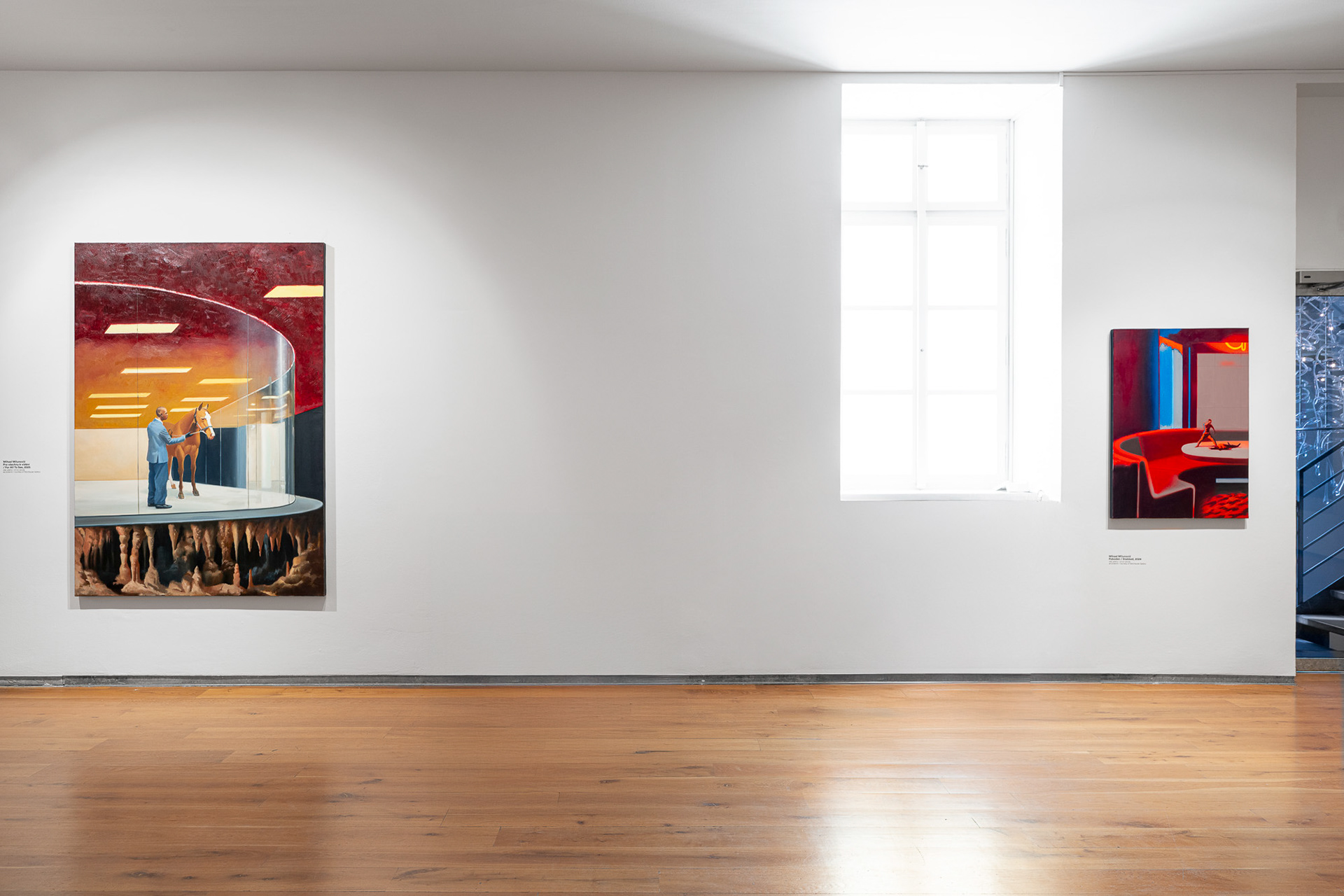
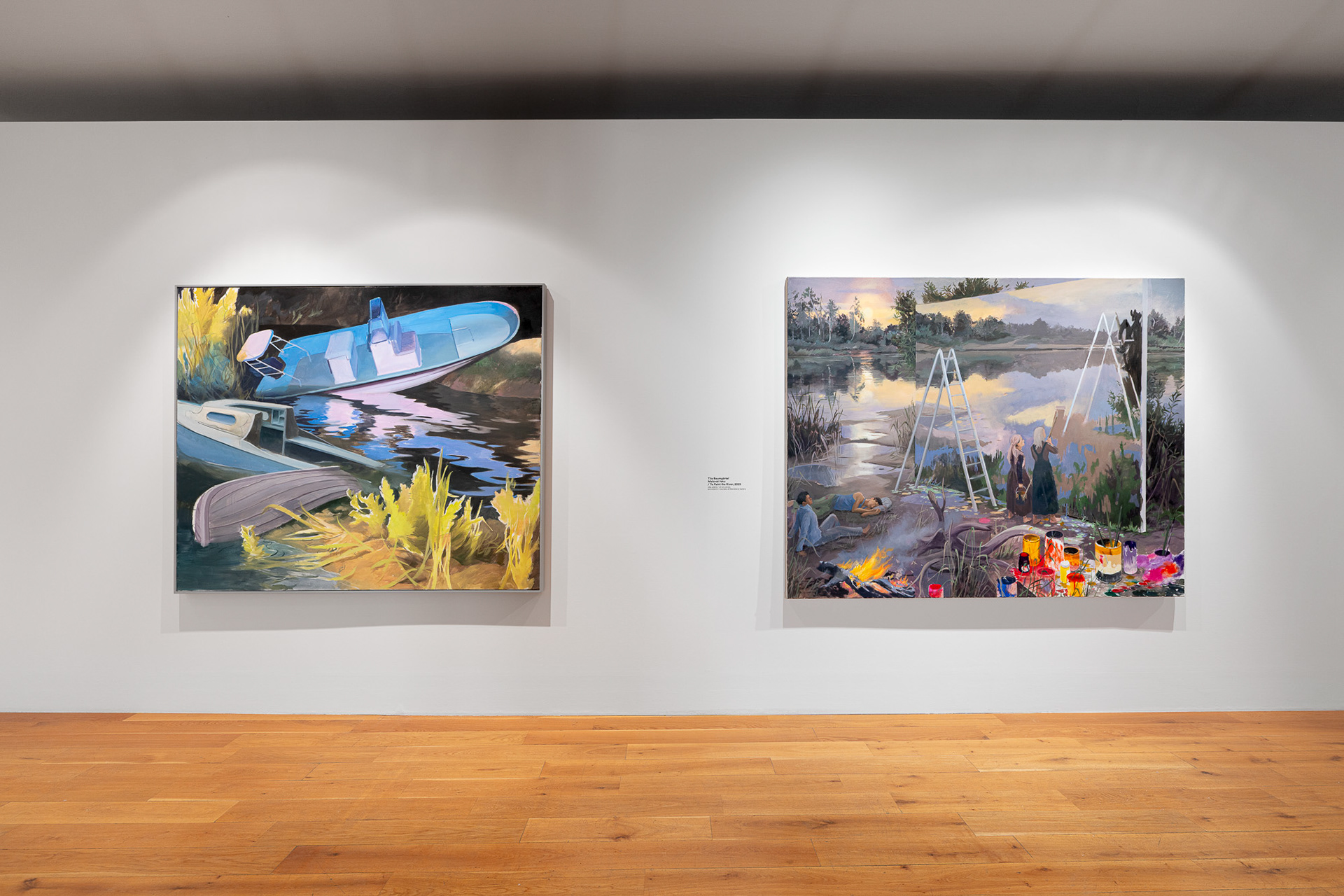
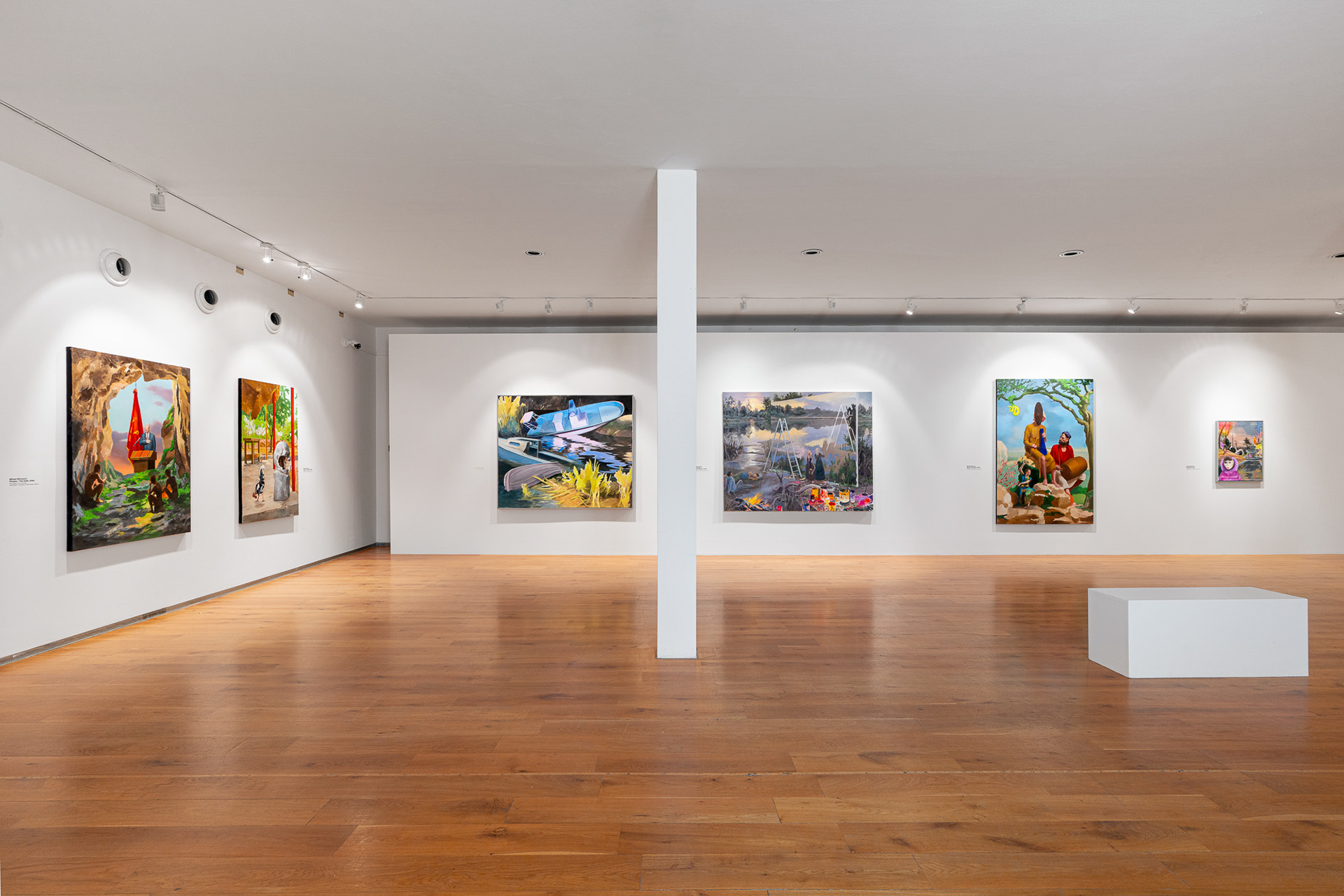
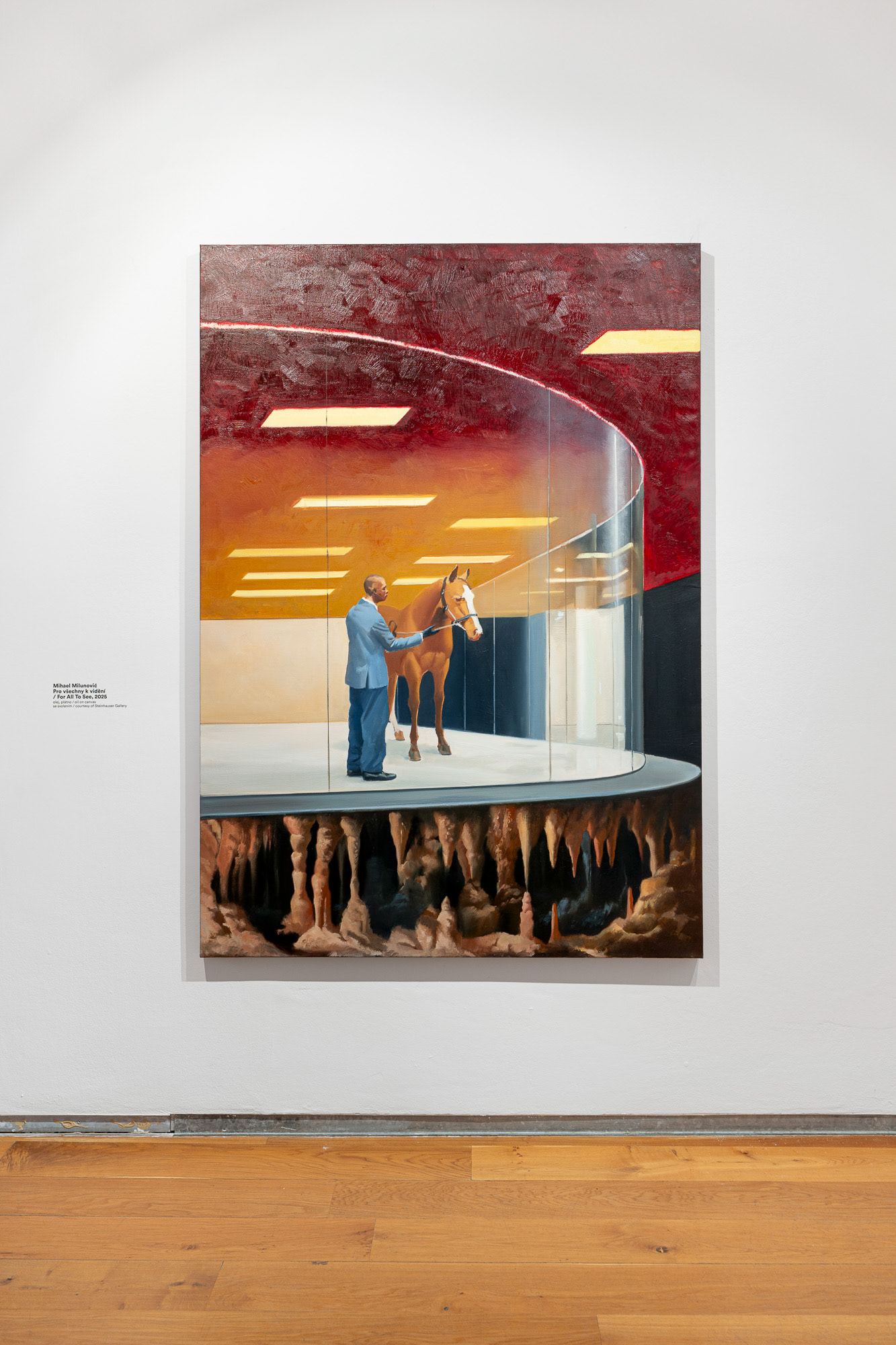
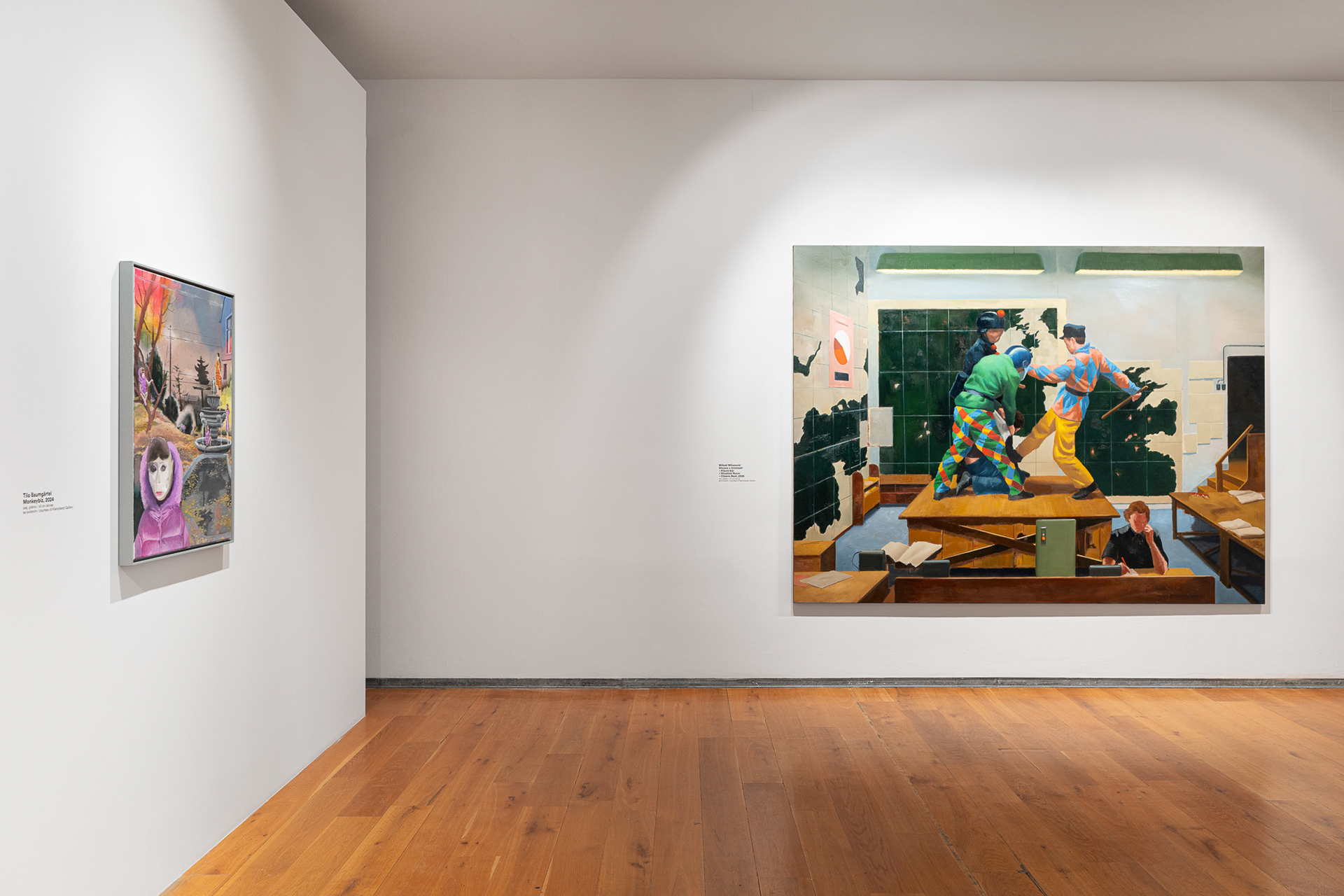
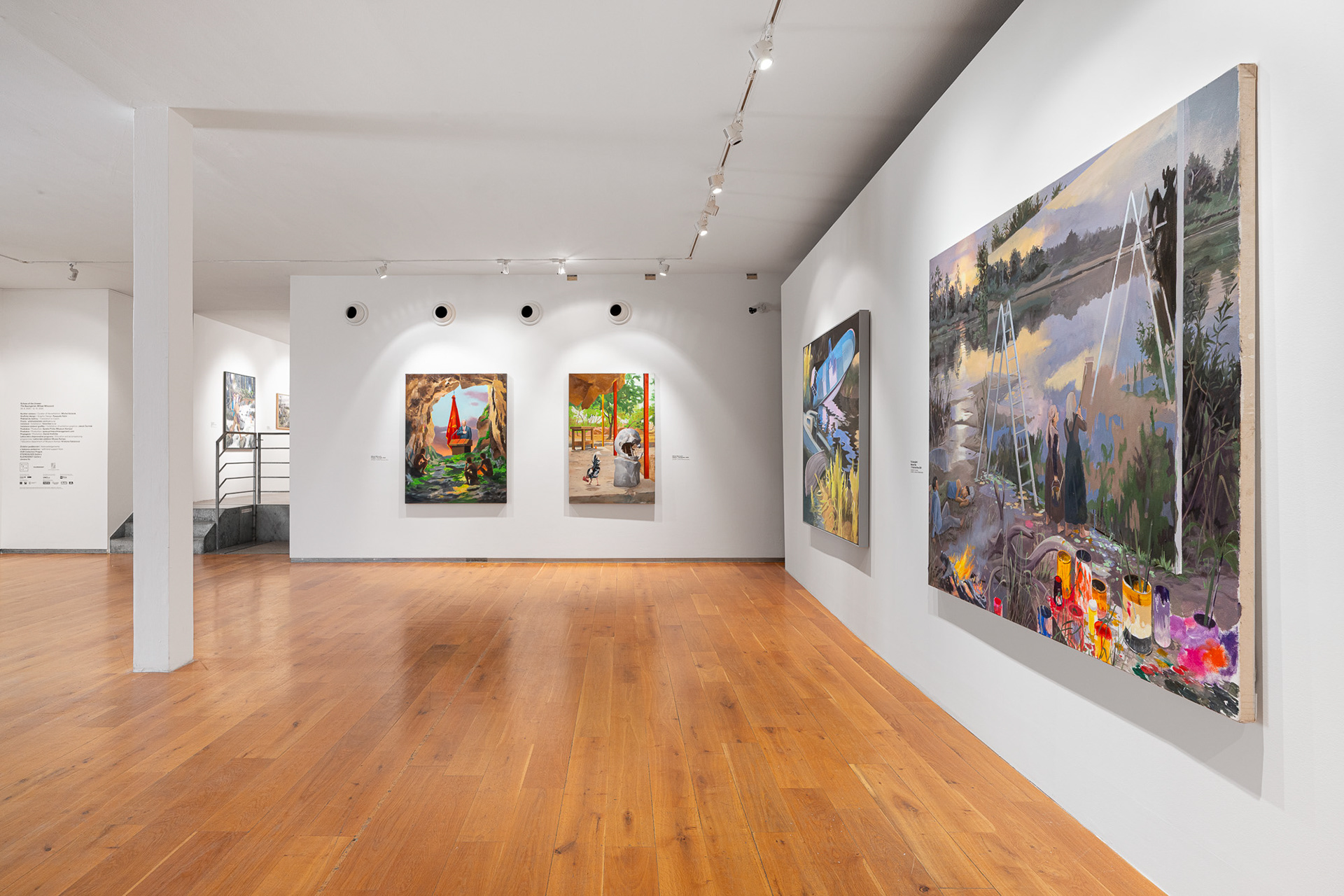
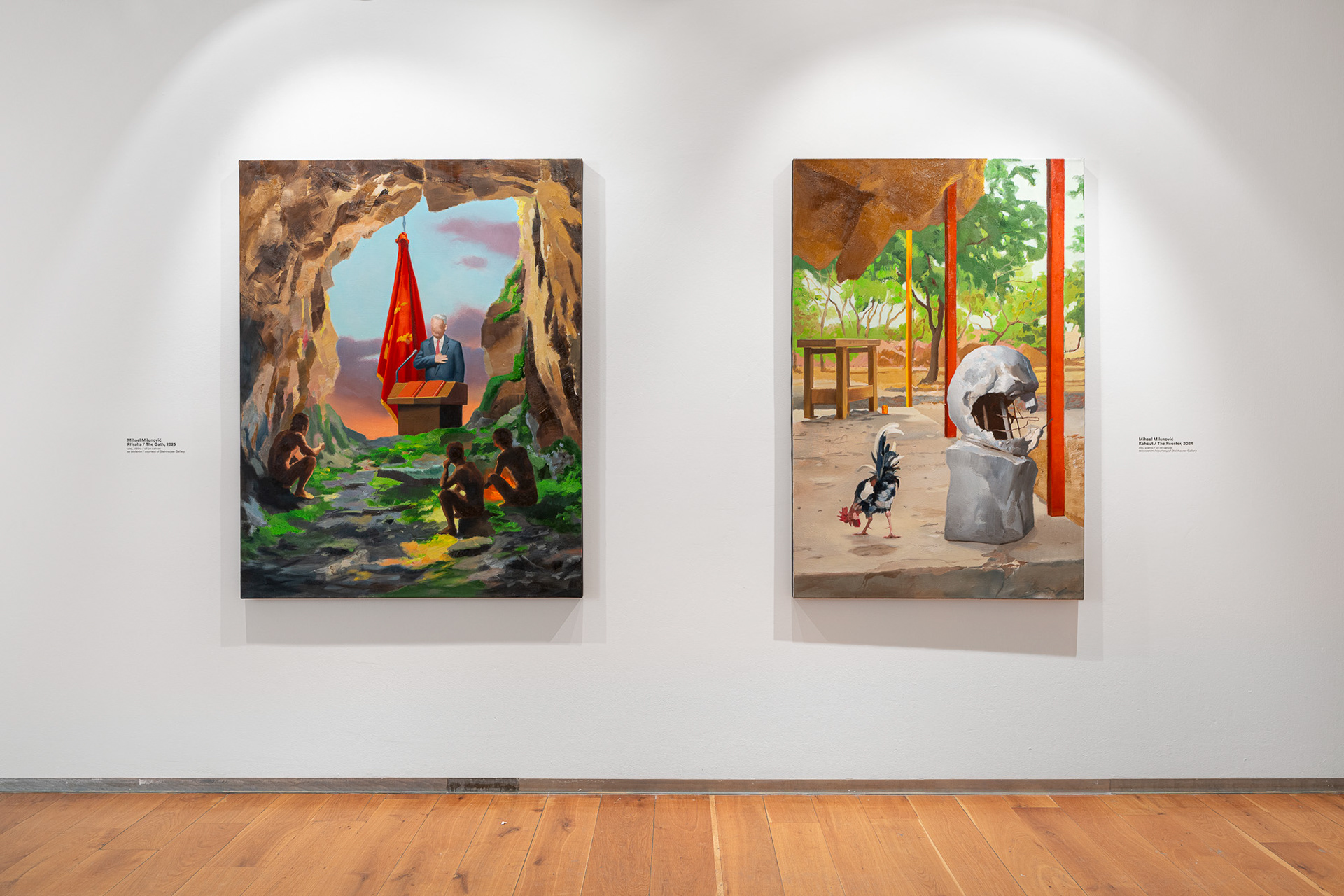
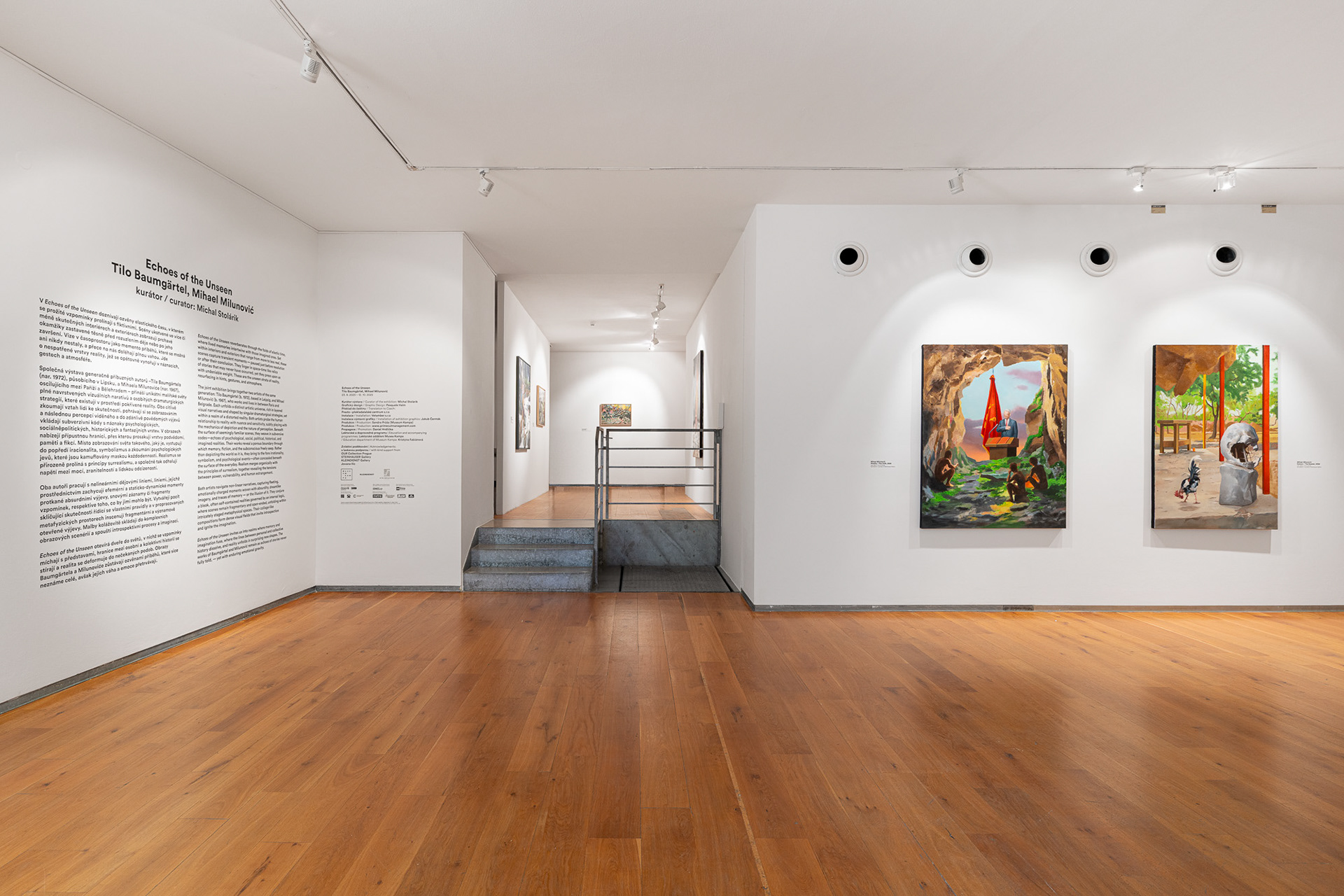
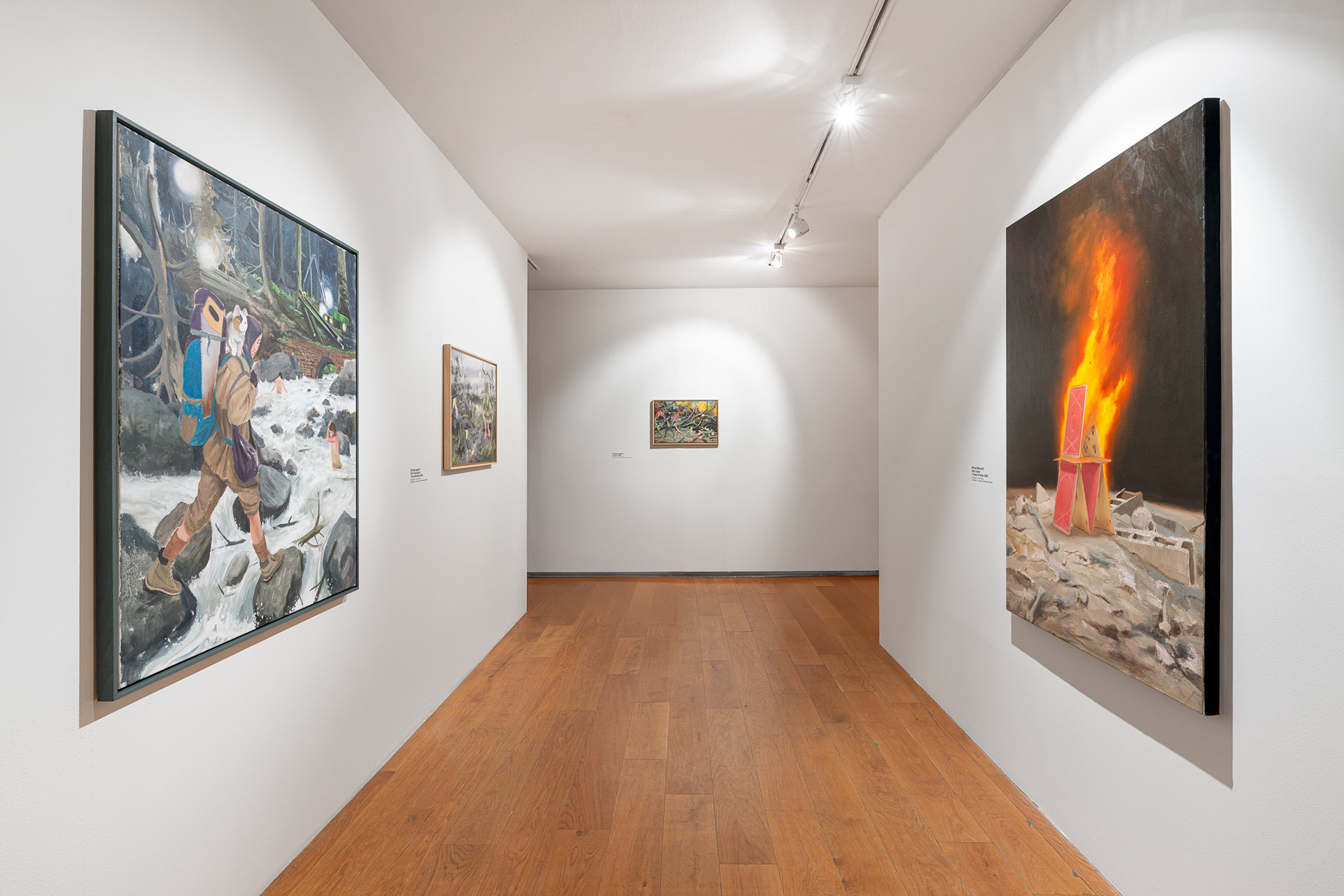
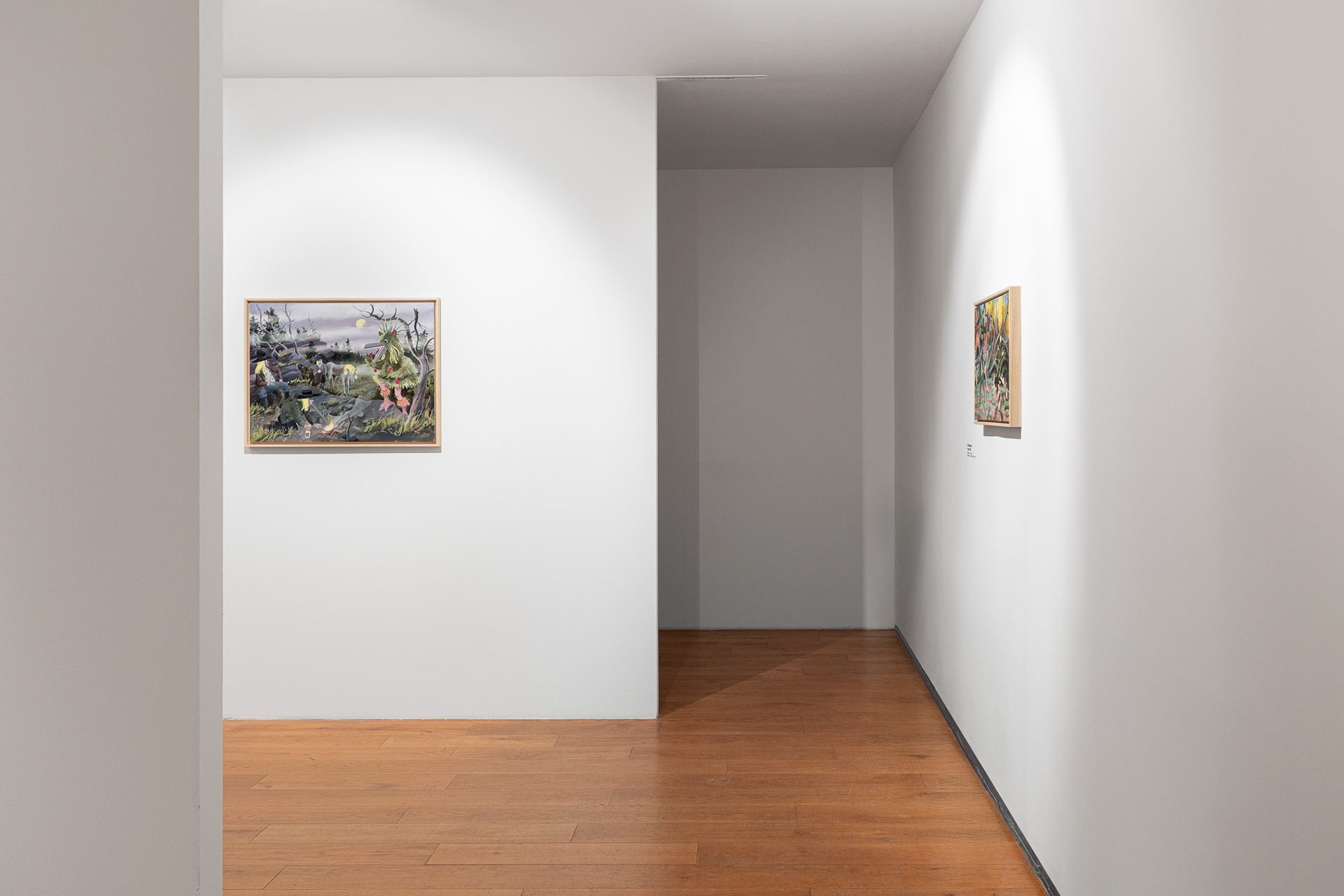
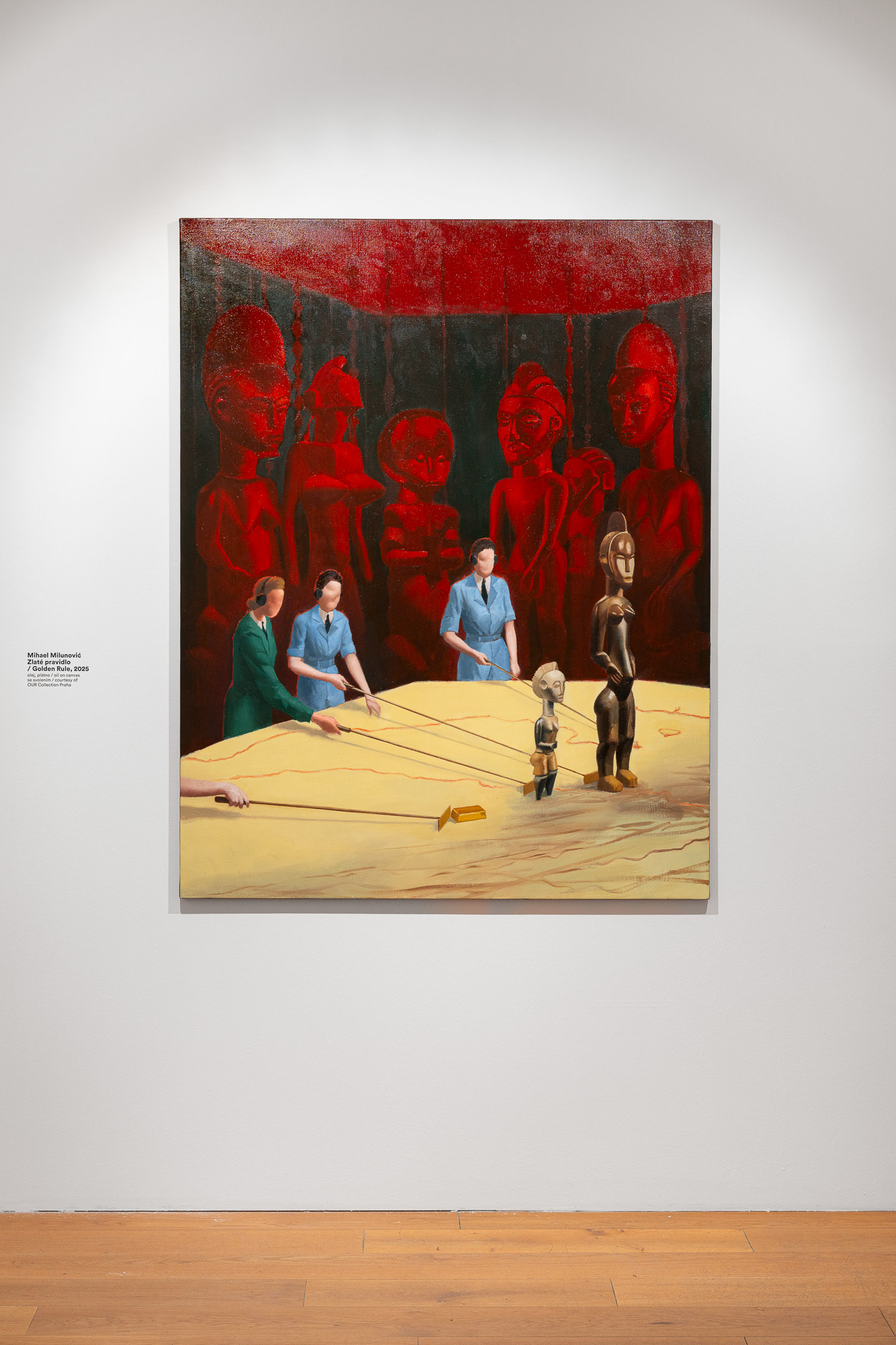
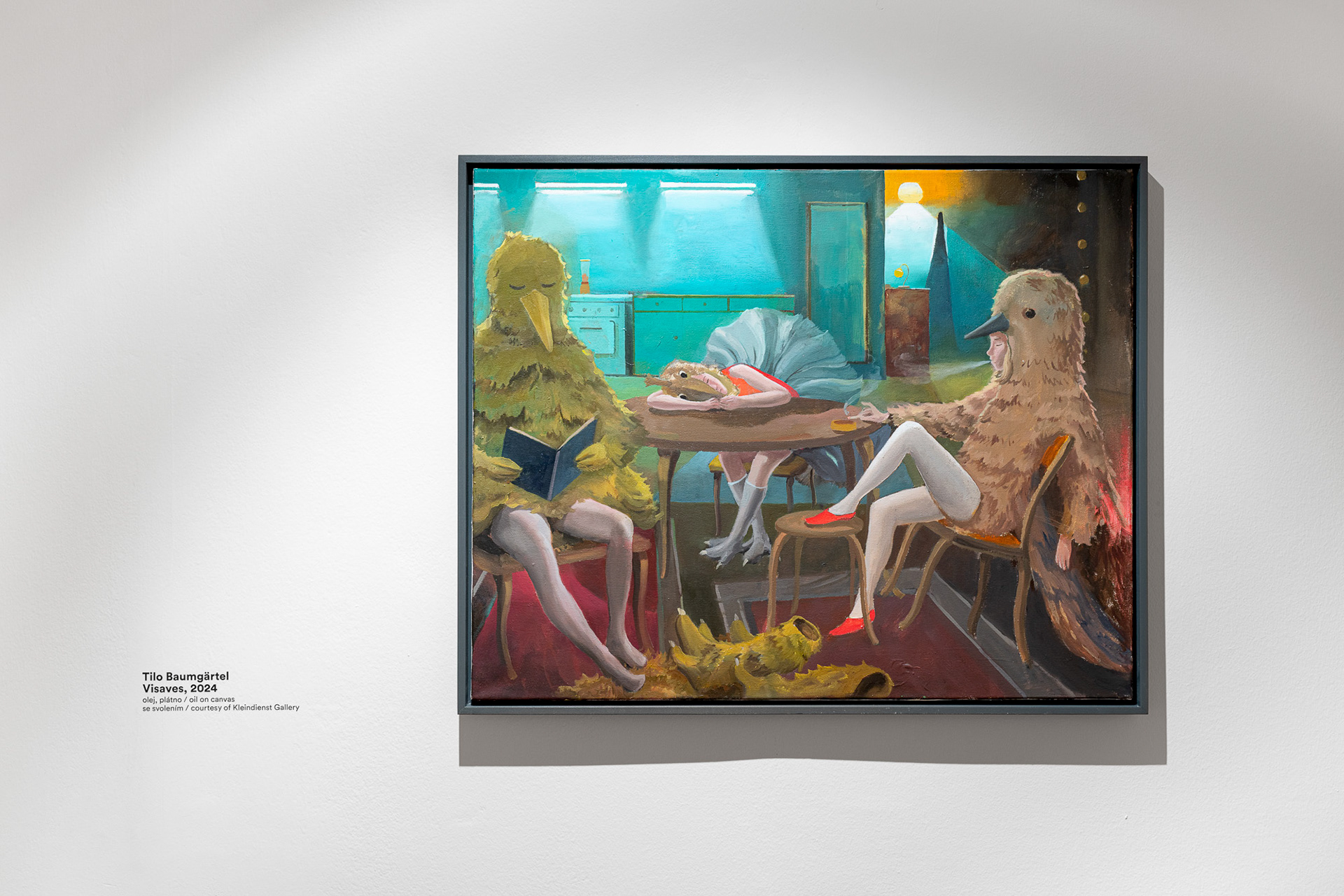
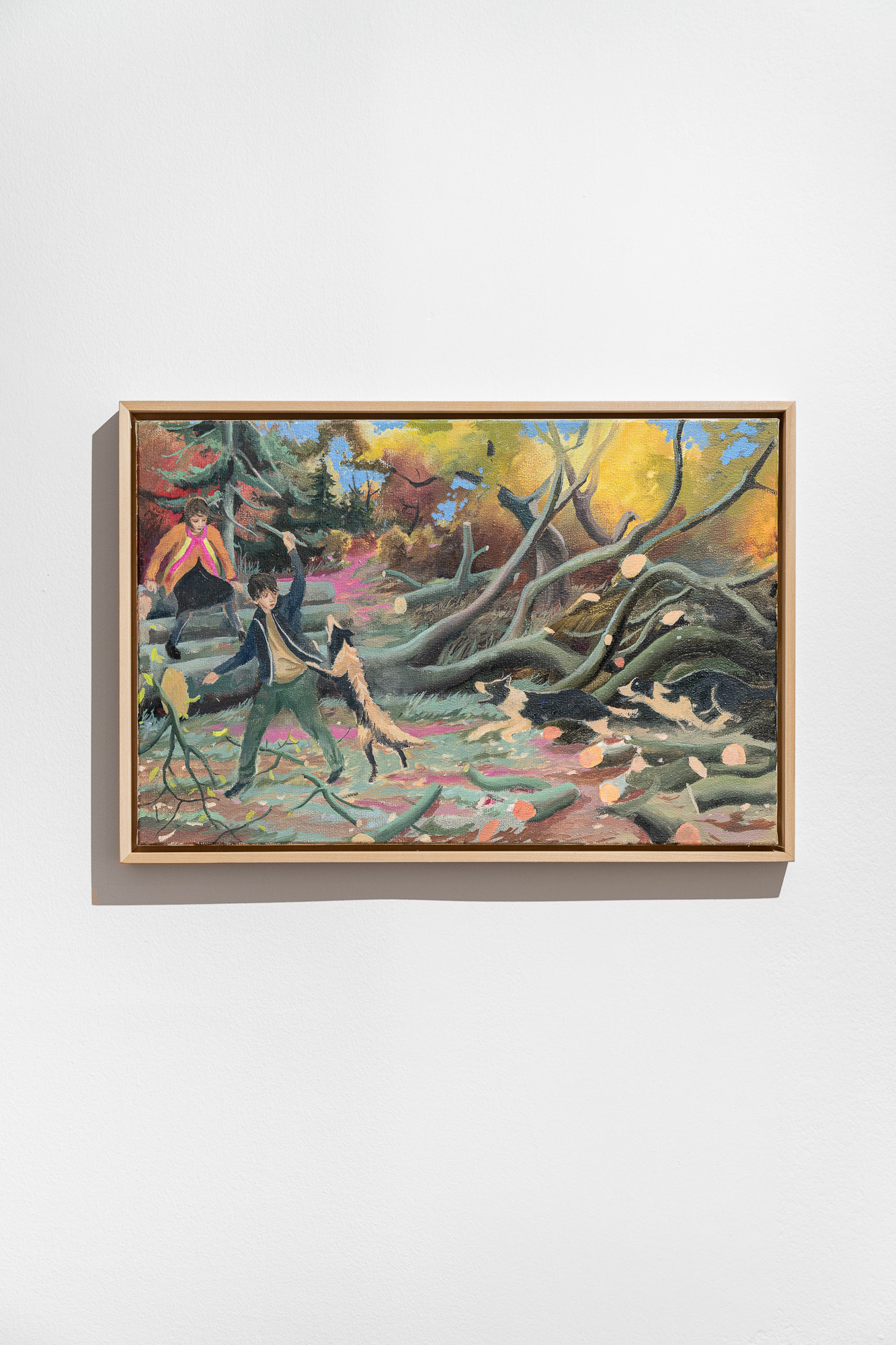
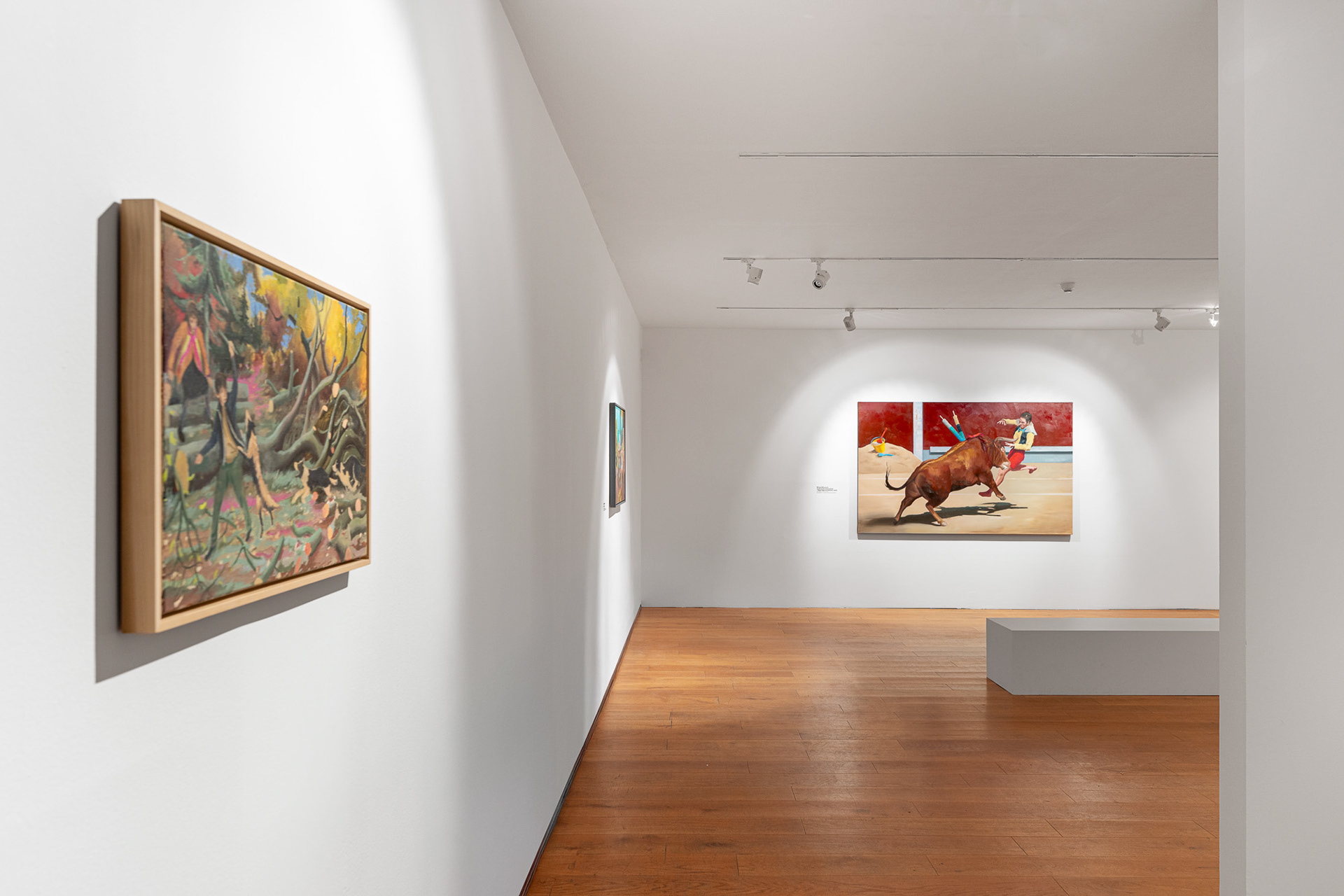
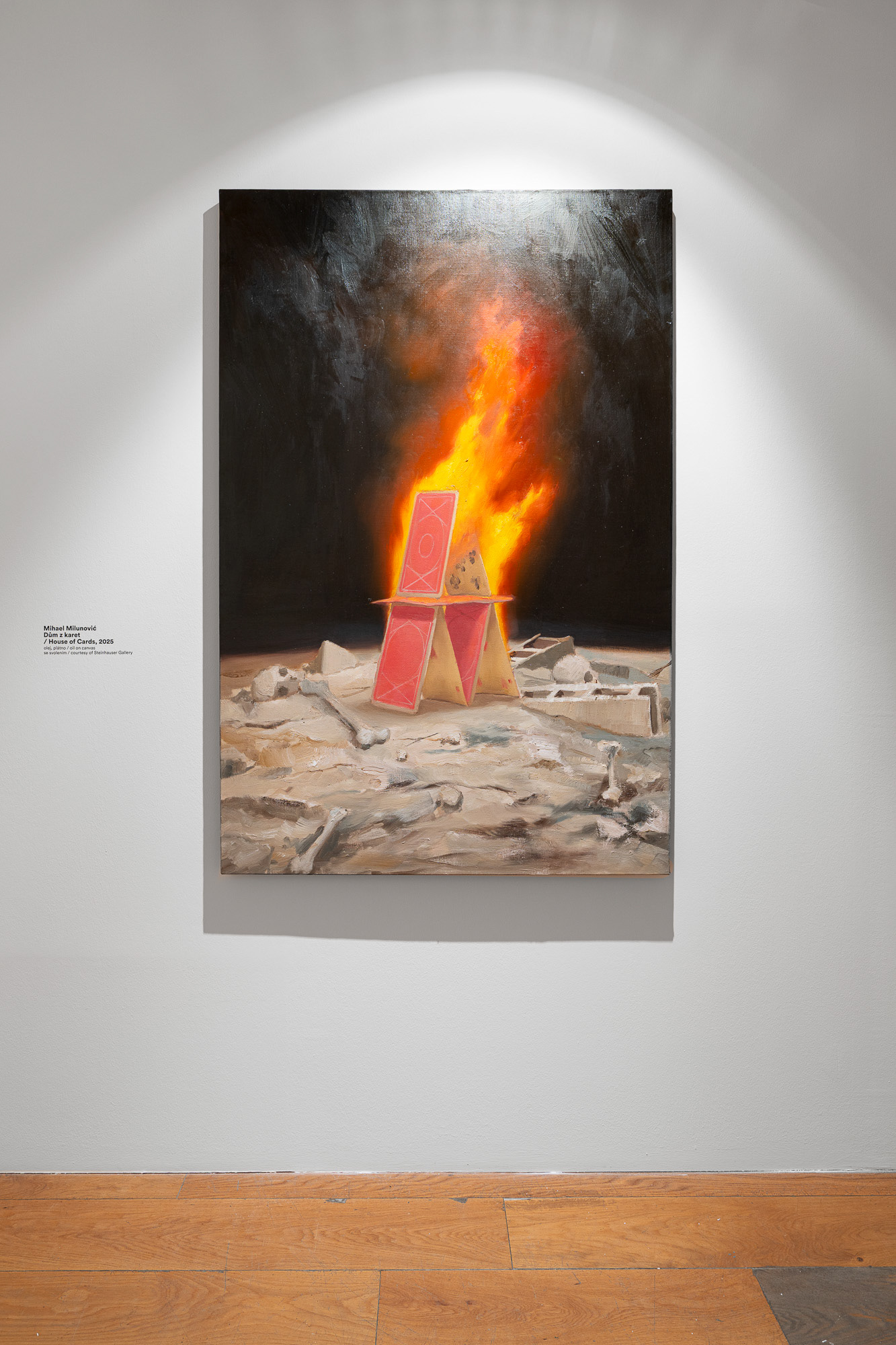
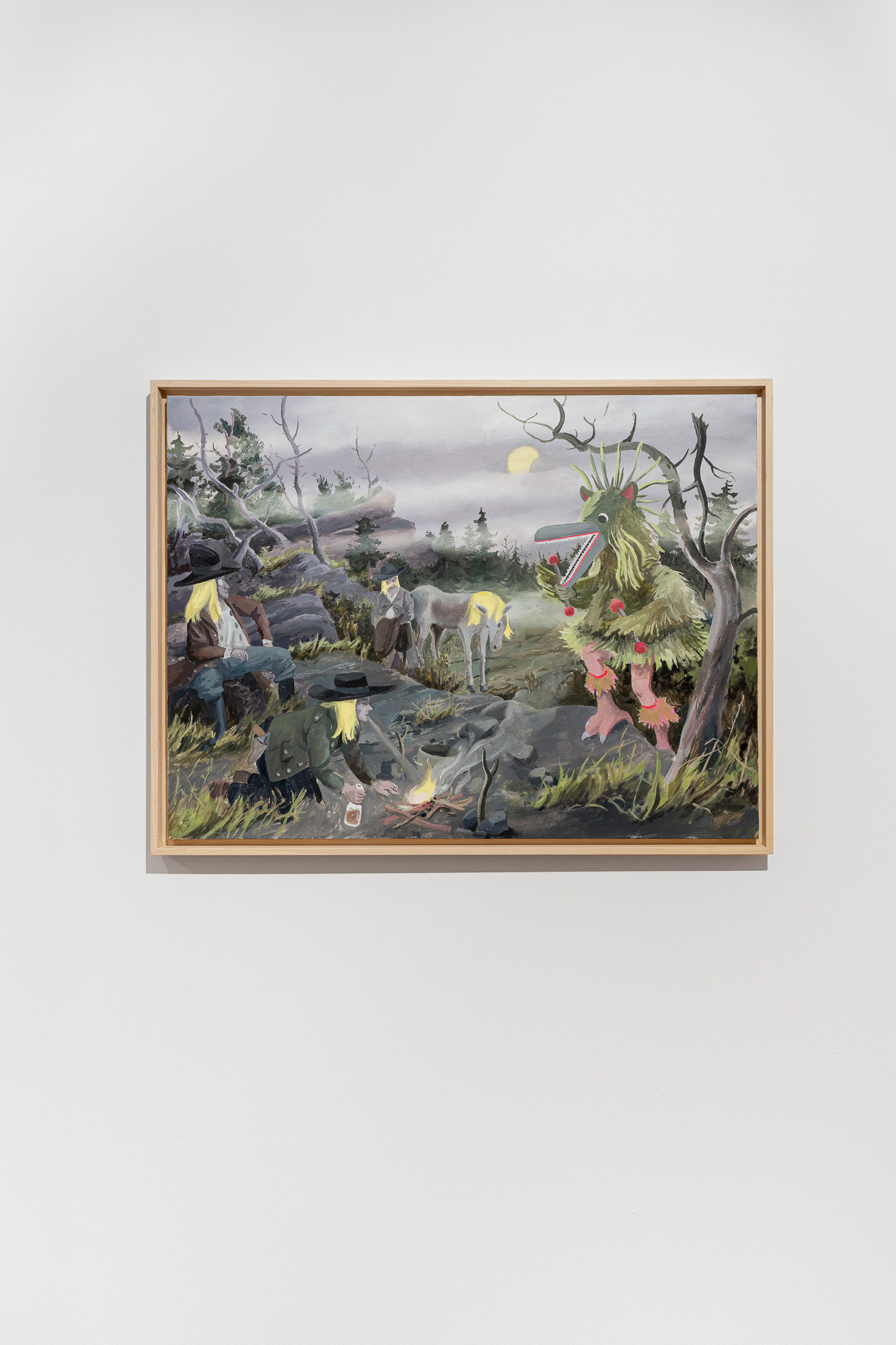
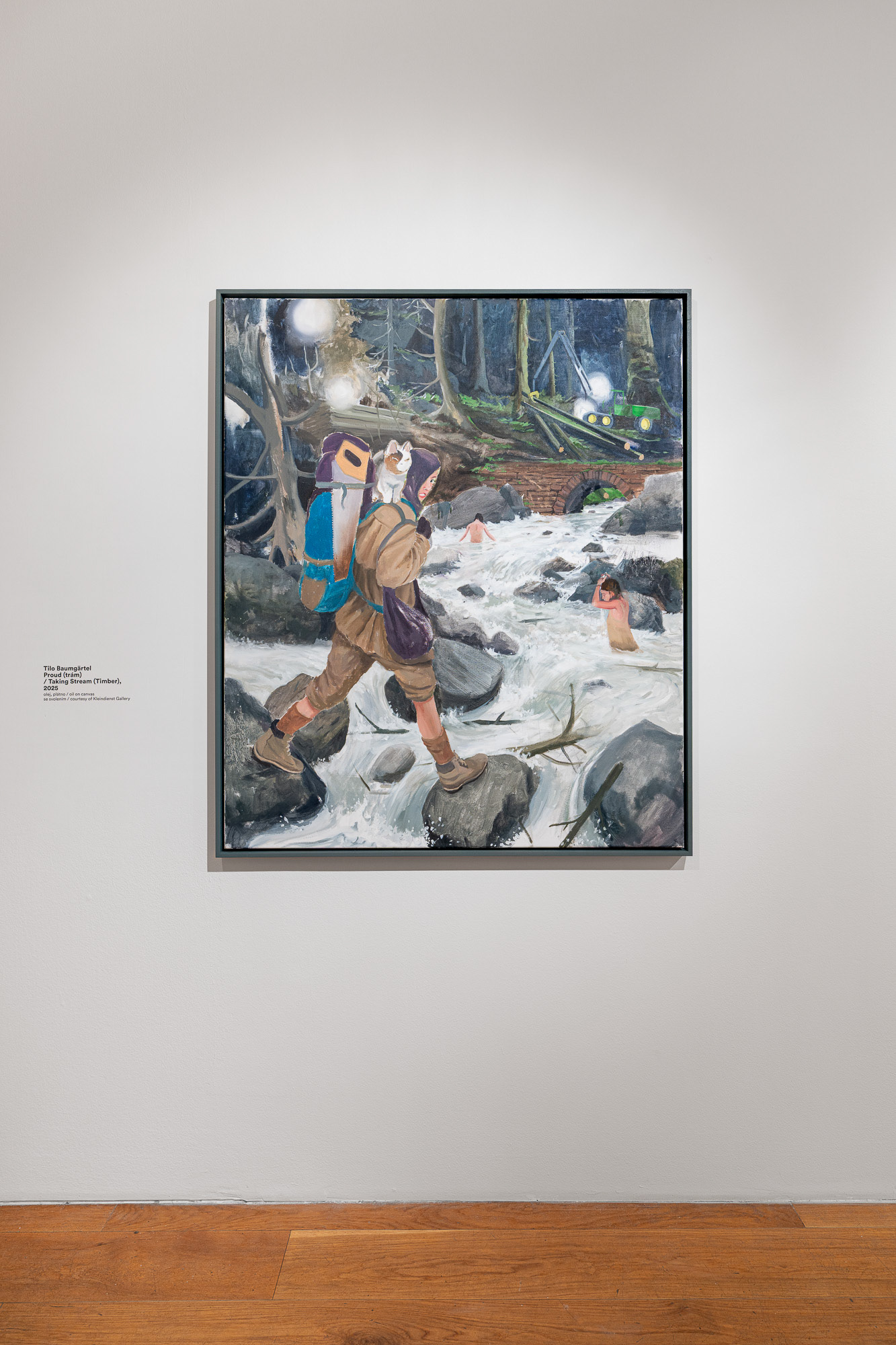
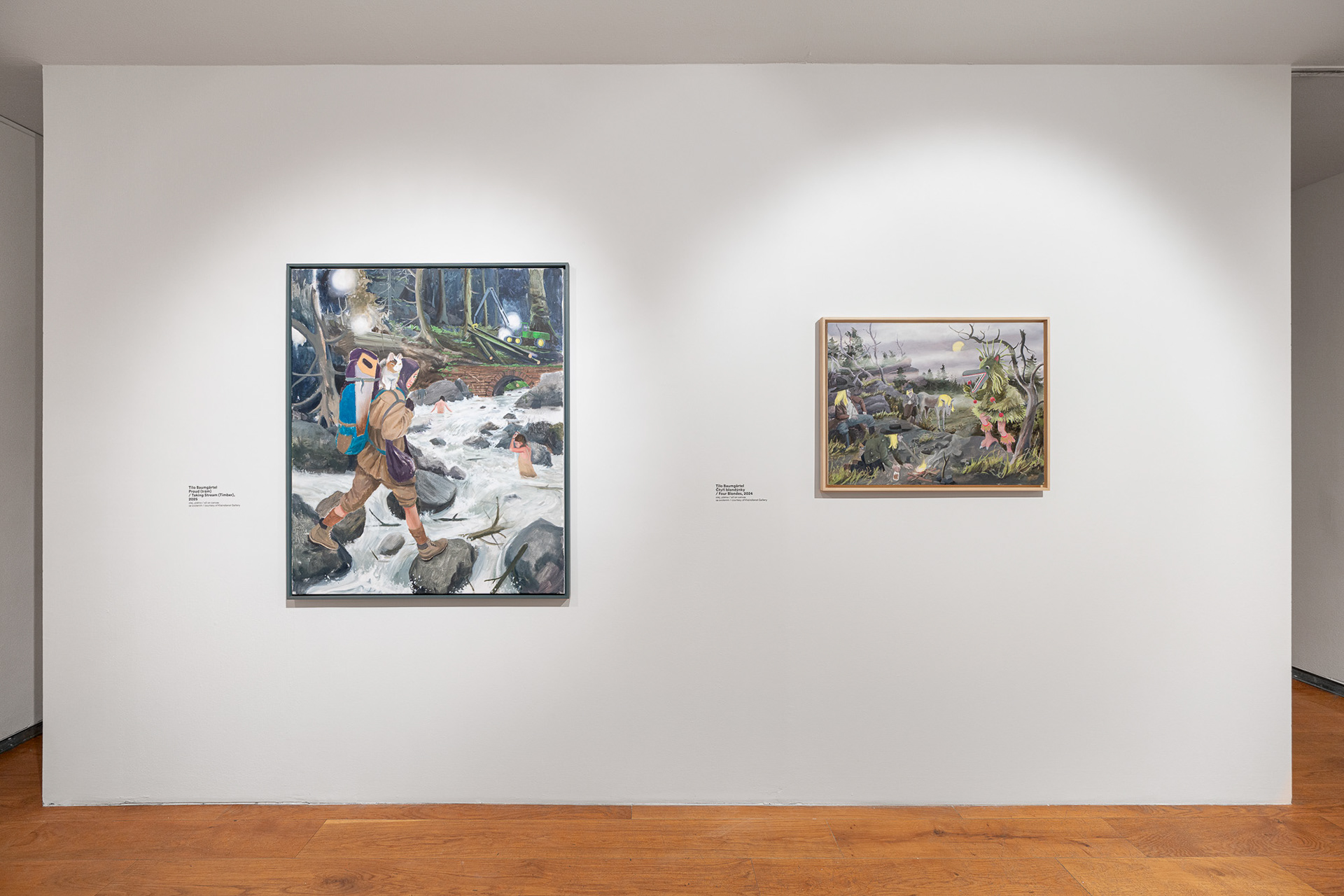
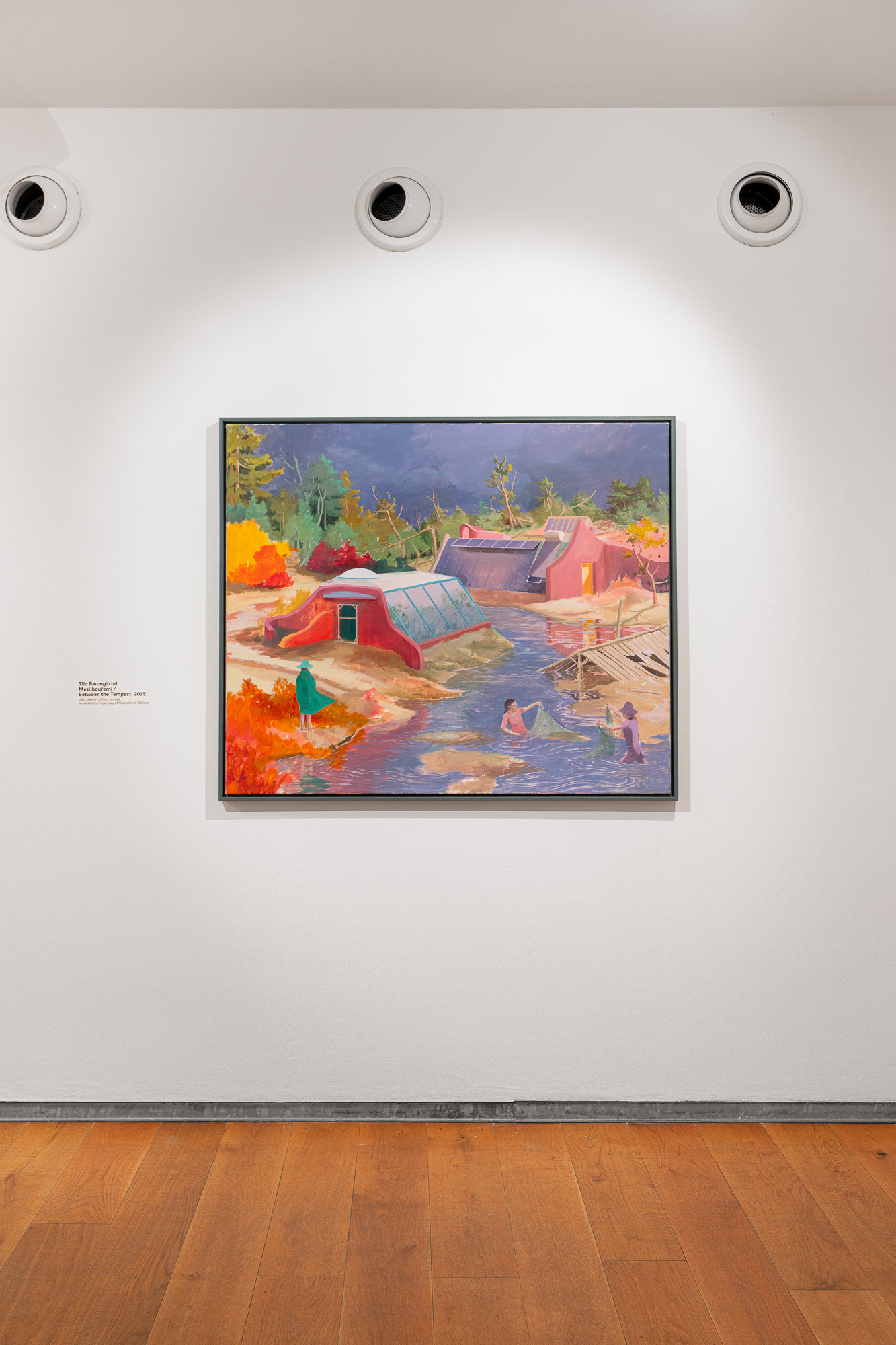
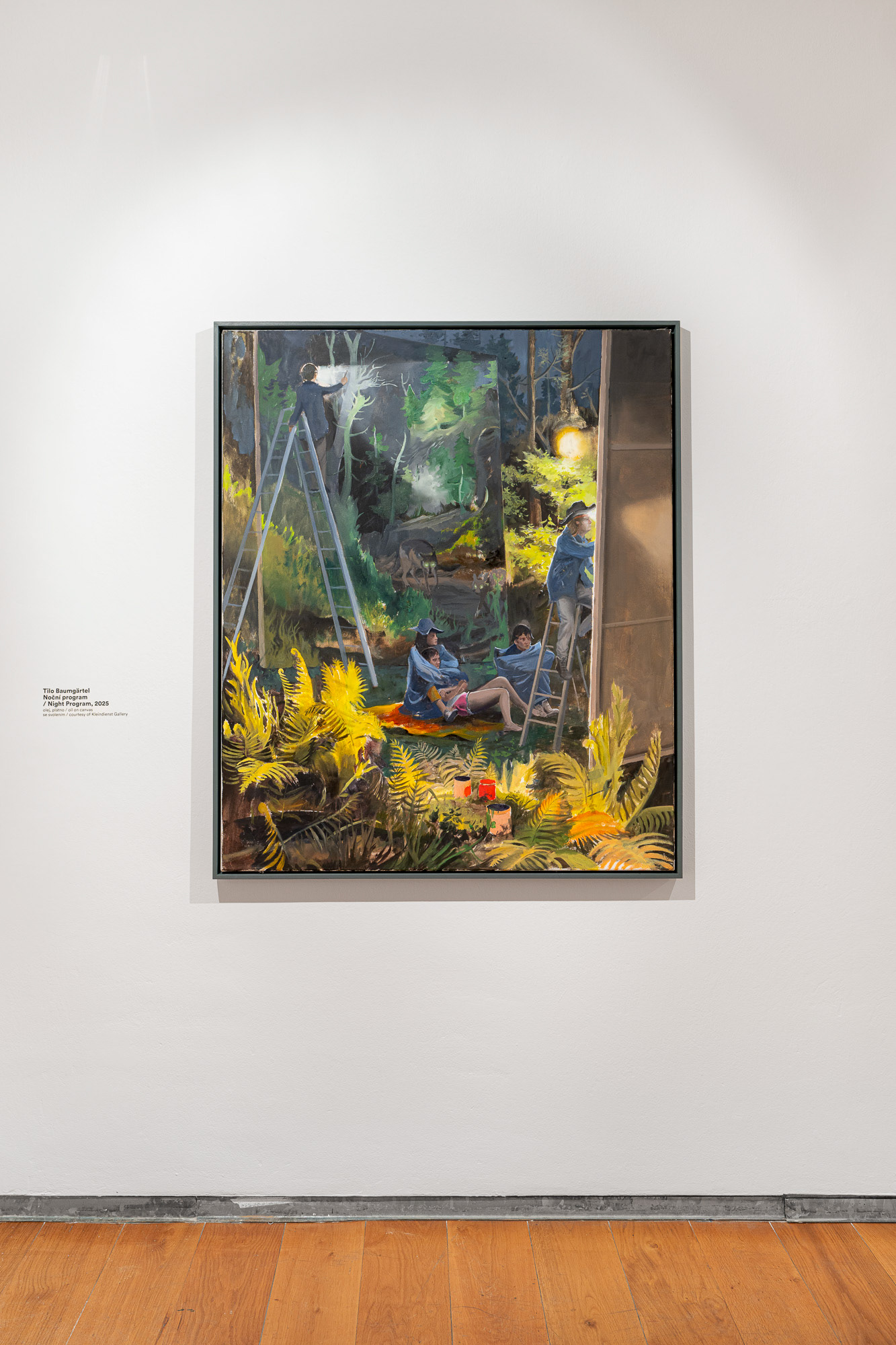
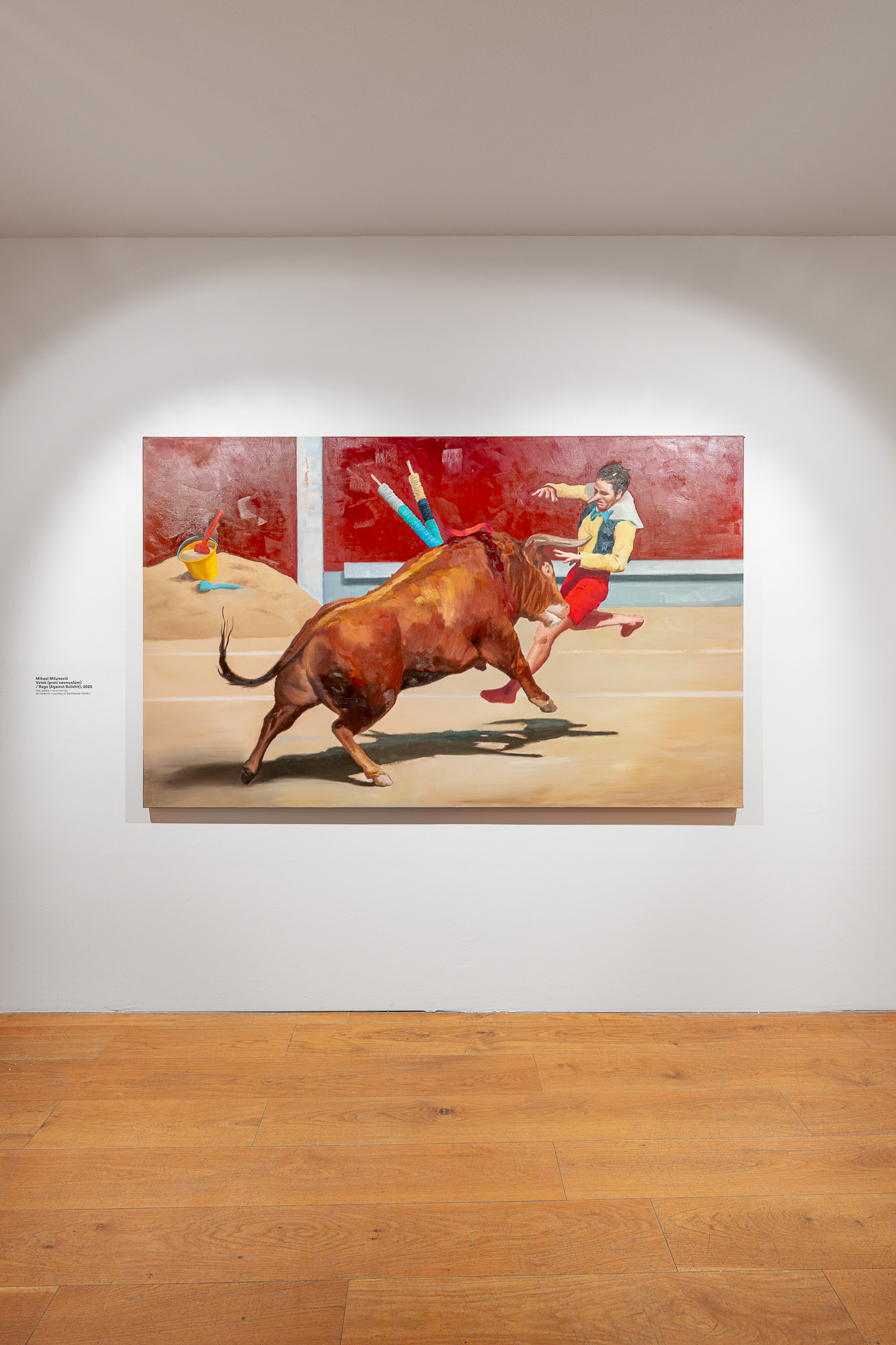
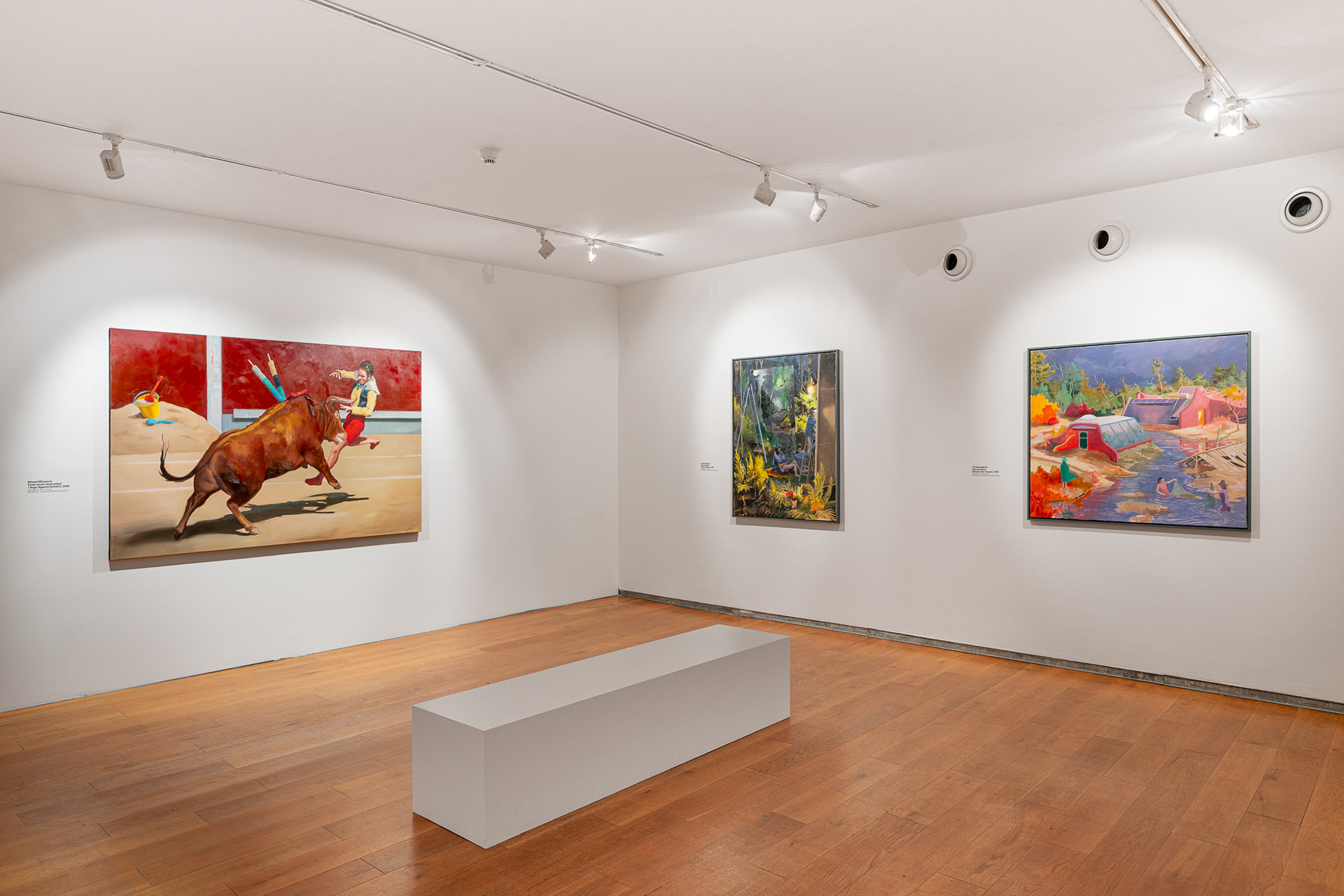
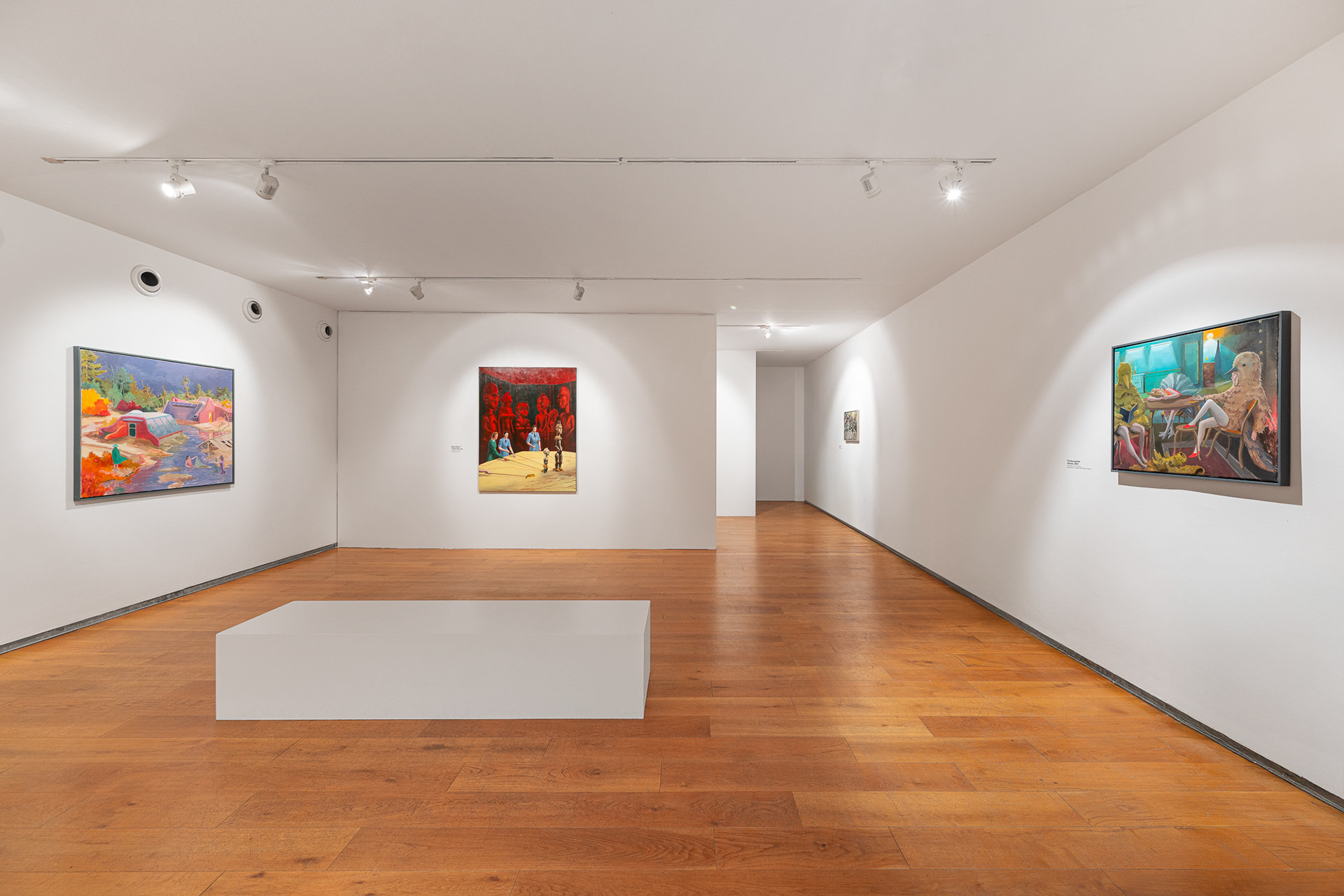
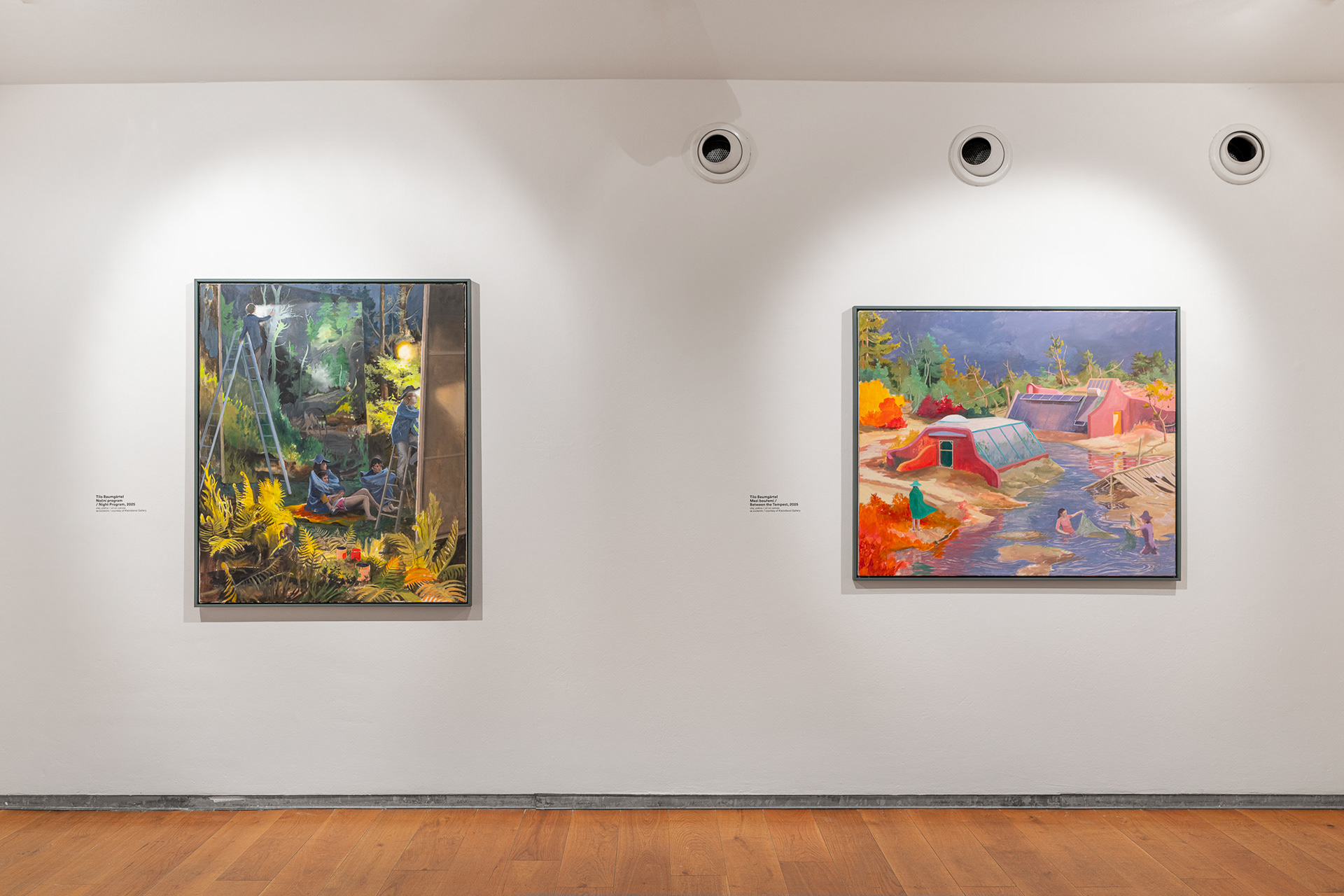
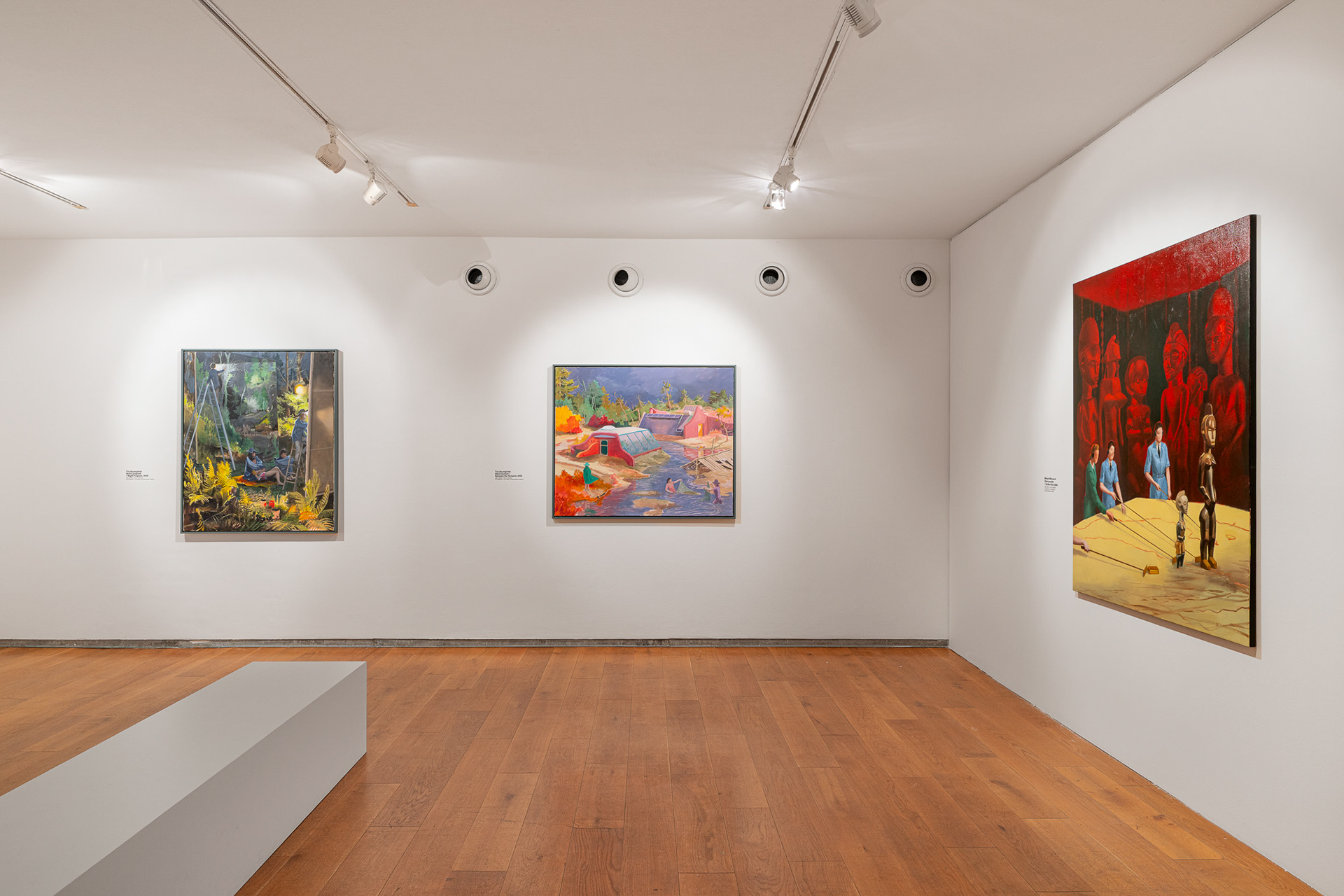
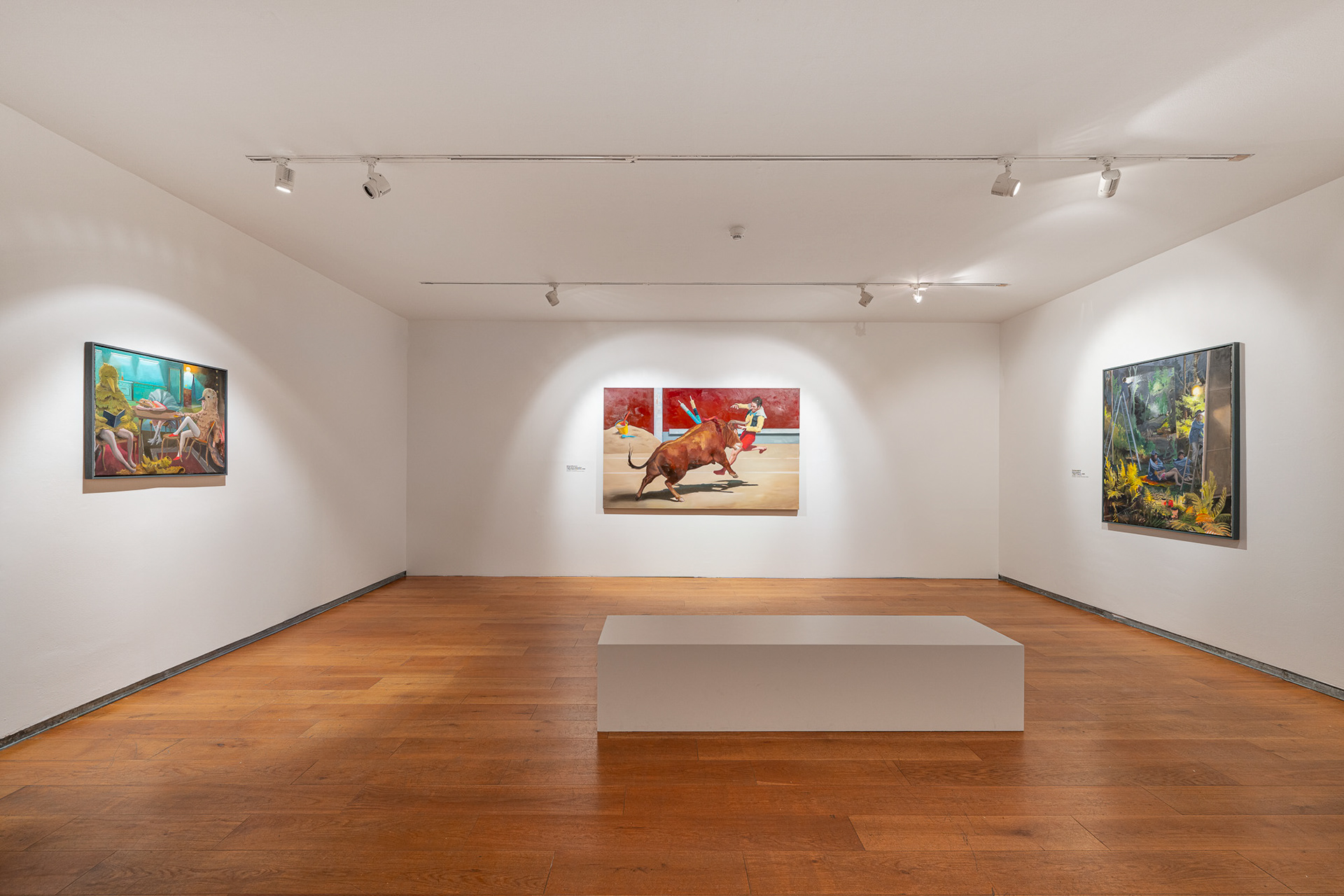
Echoes of the Unseen reverberates through the folds of elastic time, where lived memories intertwine with those imagined ones. Set within interiors and exteriors that range from more to less real, these scenes capture transient moments — paused just before resolution or after their conclusion. They linger in space-time like relics of stories that may never have occurred, yet they press upon us with undeniable weight. These are the unseen strata of reality, resurfacing in hints, gestures, and atmosphere.
The joint exhibition brings together two artists of the same generation: Tilo Baumgärtel (b. 1972), based in Leipzig, and Mihael Milunović (b. 1967), who works and lives in between Paris and Belgrade. Each unfolds a distinct artistic universe, rich in layered visual narratives and shaped by singular dramaturgical strategies, set within a realm of a distorted reality. Both artists probe the human relationship to reality with nuance and sensitivity, subtly playing with the mechanics of depiction and the nature of perception. Beneath the surface of seemingly familiar scenes, they weave in subversive codes—echoes of psychological, social, political, historical, and imagined realities. Their works reveal a porous boundary through which memory, fiction, and the subconscious freely seep. Rather than depicting the world as it is, they bring to the fore irrationality, symbolism, and psychological events—often concealed beneath the surface of the everyday. Realism merges organically with the principles of surrealism, together revealing the tensions between power, vulnerability, and human estrangement.
Both artists navigate non-linear narratives, capturing fleeting, emotionally charged moments woven with absurdity, dreamlike imagery, and traces of memory — or the illusion of it. They conjure a bleak, often self-contained realities governed by an internal logic, where scenes remain fragmentary and open-ended, unfolding within intricately staged metaphysical spaces. Their collage-like compositions form dense visual fields that invite introspection and ignite the imagination.
At the heart of these often-tense scenarios are figures whose presence invites a flurry of questions. In Baumgärtel’s work, they appear as silent yet active agents, embedded within the scene. Milunović stages his characters with theatrical precision, placing them within a carefully orchestrated mise-en-scène. They bewilder the viewer with their ambiguous proportions and elusive nature, in an environment where natural elements often contrast with brutalist and modernist architectural forms. While Baumgärtel’s compositions may initially resemble cinematic stills, subtle dislocations, visual ellipses and quiet ruptures gradually unsettle the scene, leaving his characters balance between the familiar and the unknown.
Themes of masks and costumes serve as vessels of meaning in both artists’ paintings, engaging with symbolism, representation, and associated identity. In Milunović’s work, uniform-like garments echo formal or ideologically coded attire. This is often reinforced by the recurring presence of faceless figures, heightening a sense of anonymity, or a staged, ritualistic act. Baumgärtel’s characters appear civilian, and thereby offering potential triggers for personal introspection. In some works, figures appear in animal masks or carnival costumes, lending the works an absurdist flair, whilst also unveiling emotional and human dimension of the characters.
Natural elements and architectural structures offer the scenes movement, symbolic depth, and emotional resonance. In Baumgärtel’s paintings, landscapes take on a cinematic quality: wild rivers, flooded plains, dense forests, and nocturnal settings lit by dramatic sources that heighten their dreamlike tone and psychological tension. Water becomes a symbol of resilience, constant flux, and life itself. Architecture, by contrast, functions more as backdrop, — framing a dialogue between the natural and the constructed. At times, the absurdity of a scene is amplified by monumental canvases that mirror the surrounding landscape, subtly revealing the paradoxes of representation.
Milunović often sets nature in confrontation with architecture, opulent interiors, and modernist forms. These elements enter into dialogue as symbols of memory, power, and control, generating tension between the organic and the constructed. Clean lines and monumental proportions, paired with intense lighting, accentuate the performative nature of the scenes, drawing us into theatrical or dystopian realms. Yet, natural formations, too, take on architectural roles; — caves, for instance, evoking shelter and refuge. Fire remains the most potent natural force, though: not only a symbol of destruction, but also of purification, resistance, and renewal.
Echoes of the Unseen invites us into realms where memory and imagination fuse, where the lines between personal and collective history dissolve, and reality unfolds in surprising new shapes. The works of Baumgärtel and Milunović remain as echoes of stories never fully told, — yet with enduring emotional gravity.
V Echoes of the Unseen doznievajú ozveny elastického času, v ktorom sa prežité spomienky prelínajú s fiktívnymi. Scény ukotvené vo viac či menej skutočných interiéroch a exteriéroch zobrazujú prchavé momenty, zastavené tesne pred rozuzlením deja alebo po jeho zavŕšení. Visia v časopriestore ako memento príbehov, ktoré sa možno ani nikdy nestali, a predsa na nás doliehajú plnou váhou. Ide o nevidené vrstvy reality, ktoré sa opätovne vynárajú v náznakoch, gestách a atmosfére.
Spoločná výstava generačne príbuzných autorov –Tila Baumgärtela (1972), pôsobiaceho v Lipsku, a Mihaela Milunovića (1967) oscilujúceho medzi Parížom a Belehradom – prináša unikátne maliarske svety plné navrstvených vizuálnych naratívov a osobitých dramaturgických stratégií, ktoré existujú v prostredí pokrivenej reality. Obaja citlivo skúmajú vzťah ľudí k skutočnosti, pohrávajú sa so zobrazovaním a následnou percepciou videného, a do zdanlivo povedomých výjavov vkladajú subverzívne kódy s náznakmi psychologických, sociálno-politických, historických a fantazijných vrstiev. V obrazoch ponúkajú priepustnú hranicu, cez ktorú presakujú vrstvy podvedomia, pamäti a fikcie. Namiesto zobrazovania sveta takého, aký je, vystupujú do popredia iracionalita, symbolizmus a skúmanie psychologických javov, ktoré sú kamuflované maskou každodennosti. Realizmus sa prirodzene prelína s princípmi surrealizmu, a spoločne tak odhaľujú napätie medzi mocou, zraniteľnosťou a ľudskou odcudzenosťou.
Obaja autori pracujú s nelineárnymi dejovými líniami, prostredníctvom ktorých zachytávajú efemérne a staticko-dynamické momenty pretkané absurdnými výjavmi, snovými záznamami či fragmentmi spomienok, respektíve toho, čo by nimi mohlo byť. Vytvárajú pocit skľučujúcej skutočnosti riadiacej sa vlastnými pravidlami a v prepracovaných metafyzických priestoroch inscenujú fragmentárne a významovo otvorené výjavy. Maľby kolážovito vyskladávajú do komplexných obrazových scenérií, a spúšťajú introspektívne procesy a imagináciu.
Niekde do centra týchto – často vypätých situácií – sú kladené postavy, ktorých prítomnosť vyvoláva množstvo otázok. Kým Baumgärtelovi hrdinovia sú tichými, no zároveň aktívnymi účastníkmi kompozícií, Milunović s nimi pracuje ako s hercami v starostlivo režírovaných scénach. Tie diváka mätú svojimi nejasnými proporciami a neuchopiteľnou povahou, pričom často stavia do kontrastu prírodné prvky s brutalistickými a modernistickými architektonickými formami. Hoci Baumgärtelove kompozície na prvý pohľad pôsobia prirodzene, takmer ako filmové zábery, sú to práve drobné posuny, vizuálne skraty a nenápadné narušenia reality, ktoré postupne vyvolávajú zneistenie a nechávajú postavy balansovať na hrane medzi známym a neznámym.
Motívy masiek a kostýmov sa v autorových obrazoch správajú ako nositelia významov, ktoré pracujú so symbolikou, reprezentáciou či pridruženou identitou. V Milunovićovej tvorbe často vidíme uniformné oblečenie, ktoré je inšpirované formálnymi oblekmi či ideologicky zafarbeným dress codom. S ňou je previazaný aj frekventovaný motív vymazaných tvárí, ktoré akcentujú pocity anonymity či divadelno-rituálnej performancie. Baumgärtelove postavy pôsobia civilnejšie, vďaka čomu fungujú ako potenciálne spúšťače vlastnej reflexie. Vo vybraných obrazoch vystupujú figúry v zvieracích maskách či karnevalových kostýmoch, ktoré dielam síce dodávajú absurdný nádych, no zároveň odhaľujú ľudskejšiu a emocionálnejšiu polohu postáv.
Prírodné živly a architektonické prvky elementy pridávajú scénam dynamiku, symbolický rozmer či emocionálnu intenzitu. U Baumgärtela majú krajiny priam filmovú atmosféru – sledujeme divoké rieky či zatopené oblasti, nespútané lesy a nočné scény, ktoré akcentuje dramatickými svetelnými zdrojmi podčiarkujúcimi ich snovosť a psychologické napätie. Prítomnosť vody funguje ako prvok odolnosti, neustáleho pohybu či nositeľa života. Architektonické vstupy človeka tu pôsobia skôr ako kulisy, ktoré vytvárajú dialóg medzi tým, čo je prirodzené, a tým, čo je konštruované. Absurdnosť niektorých scén ešte viac zvýrazňuje prítomnosť monumentálnych maliarskych plátien, ktoré napodobňujú okolitú krajinu a poukazujú na paradoxy reprezentácie.
Milunović často konfrontuje prírodu s architektúrou, luxusnými interiérmi či modernistickými prvkami. Vstupujú do dialógu ako symboly pamäti, moci či kontroly, čím vytvárajú napätie medzi prirodzeným a umelo konštruovaným prostredím. Čisté krivky a monumentálne proporcie spolu s intenzívnym nasvietením umocňujú performatívny charakter scén a tiahnu nás do kontextu divadelných či dystopických výjavov. Architektonicky však pôsobia aj samotné prírodné štruktúry – napríklad jaskyne, ktoré zosobňujú bezpečné miesto pre ľudí. Najsilnejším prírodným živlom tu však zostáva oheň, ktorý nie je len deštruktívnou silou, ale aj znakom očisty, odporu a znovuzrodenia.
Echoes of the Unseen otvára dvere do svetov, v ktorých sa spomienky miešajú s predstavami, hranice medzi osobnou a kolektívnou históriou sa stierajú a realita sa deformuje do nečakaných podôb. Obrazy Baumgärtela a Milunovića ostávajú ozvenami príbehov, ktoré síce nepoznáme celé, no ich váha a emócie pretrvávajú.
